#ballet story analysis
Explore tagged Tumblr posts
Text
I love the story of The Nutcracker, more specifically the original short story by Eta Hoffman which inspired the ballet. The book is 14 chapters and 58 pages. The ballet is 2 acts, with each act being about an hour. Something to note is that there are other ballets, such as Swan Lake and Cinderella and Sleeping Beauty that are more than 2 acts, and are a little over than 2 hours or 2 hours and 30 minutes. The Nutcracker ballet is a good ballet and I do love it. It’s what inspired my love of ballet and dancing ballet in the first place. However, from a story perspective and an adaptation perspective, it isn’t bad, but isn’t good. This ends up hurting some characters, mostly the Nutcracker Prince himself. He does not have much personality in the ballet because there is no room to explore it. In the original story? He is sweet and attentive and devoted and loyal. He cares deeply for the other toys and Marie and wants to protect them. He feels a small disdain towards Drosselmeyer and can get a little cold when Drosselmeyer is mentioned. He is prone to moments of grouchiness and frustration when he feels that the show some citizens in the snowy forest performed for him and Marie was terrible and he apologizes to her. With the ballet version, he is shown to be caring and sweet and a little protective, but that’s really it. In ballets with more than one act, you usually have a few different scenes where the plot progresses. This is where I get into how the ballet as an adaptation of the story isn’t as good as it could be. There are many scenes in Swan Lake, where even in just the first 2 acts, the same length as the entire Nutcracker ballet, there is so much character exploration and emotional and sweet scenes. So the length of the ballet is not really a viable excuse, in my opinion. It even hurts Marie’s character. In the ballet, her big moment is her throwing her slipper at the Mouse King so he turns to her and Nutcracker has a chance to finish him. In the short story, the toys lose the first battle and so the Mouse King makes Marie give up some of her Christmas gifts and other cherished things with the threat that if she doesn’t, he will eat Nutcracker. He then will eat and chew on whatever he makes her give. This distresses her but she does it anyway. She then tells Nutcracker about it after the third night of it happening, and cries about how he may ask to eat her after everything else is gone and then nothing will be there to protect Nutcracker. He then has a short bout of coming to life where he tells her how to help him, which she previously begged him to do while crying. In the story, she’s selfless and she is quiet and a daydreamer and she worries deeply about those she cares about. In the story, after Marie throws her shoe at the Mouse King but the toys must retreat, she ends up fainting after getting a deep cut in her arm from the glass of the toy cabinet which broke and she must rest for a few days. While bedridden, Drosselmeyer tells her a long and mostly not needed backstory about a few things, but he also mentions how the Nutcrackers curse came to be. In the ballet, we don’t get an explanation as to how. It was actually the Mouse Kings mother who cursed him after the Nutcracker, at that point human, stepped on her neck when walking backwards to free someone else from their curse. (This is the needless backstory I briefly touched upon.) Drosselmeyer also gets some depth but it’s mostly how he got from the Land of Sweets where he was in the royal court to Germany, where the story takes place.
To wrap things up, I do not hate the way the ballet shows the story. I really do like it! But when you compare it and really think about it as an adaptation, it lacks in area which other ballets show is possible to be bountiful in.
#the nutcracker#The Nutcracker and the Mouse Prince#The Nutcracker ballet#ballet#ballet story analysis#my thoughts#I just really love The Nutcracker
5 notes
·
View notes
Text
The Glass Coffin: HOFAS x Elriel
Many HOFAS spoilers ahead!! This is an INTENSIVE post on all the Elriel coding in HOFAS, so strap in! This is largely a theory post and my personal interpretations, so take it or leave it! It's all in good fun.
Let's start with The Glass Coffin. When it comes to the analysis of the songs Bryce played for Azriel and Nesta in the much beloved and much dissected bonus chapter, I have seen a lot of conversation around Stone Mother and significantly less (if any?) around The Glass Coffin!
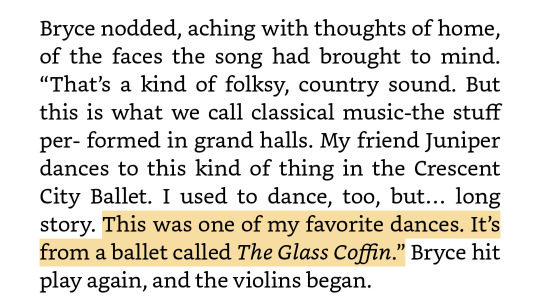
The Glass Coffin is played next after the Stone Mother. And it is a ballet.
What is the The Glass Coffin?
My friends, it is Sleeping Beauty.
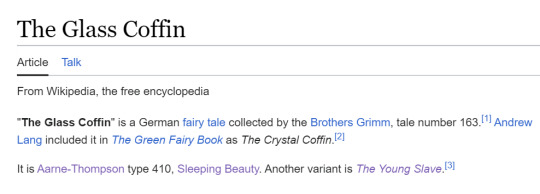
Now we all know that many suspect Elriel to be a Sleeping Beauty retelling. And I'll be honest, I take a lot of the mythology or "retellings" with a grain of salt when it comes to SJM, because she doesn't do incredibly loyal retellings but takes bits and pieces of inspiration. I suppose it's up to you where you draw the line of a retelling, or free IP inspiration. But one thing to understand about IP is that Sarah J. Maas would have to get Disney's permission to call her work a retelling of Disney's Sleeping Beauty. Much like Beauty and The Beast, she did not "retell" the Disney princess movie, but the original La Belle et la Bête by Gabrielle-Suzanne Barbot de Villeneuve published in 1740. So with that little lesson in intellectual property, lets look at the story of The Glass Coffin, because it is actually quite interesting:

A magician forces a proposal on a Maiden using his magic. The Maiden is repulsed by the use of magic in the proposal and rejects him. The Magician turns her brother into a stag, traps her in the glass coffin, and enchants the land around them.
There is a LOT to unpack here. I do not think Lucien is "The Magician" in this story. Instead, I think the Cauldron is, and I do think that the use of magic to force a proposal is a very close parallel to what Azriel discovered in HOFAS: That the Cauldron had been corrupted by the Asteri to serve their will. If you have read all of the books in the multiverse, you know that there is no other SJM universe where mating bond rejections happen. There is no other universe in which there are unhappily mated pairs forced together because the function of the mating bond, at a base level, is simply to produce the most powerful offspring. Mates in other worlds are true soulmates, and they fall in love before discovering they are mates.
In HOFAS, Azriel listened to a song from The Glass Coffin. He also listened to the story of Silene, and learned that the Cauldron was corrupted by the Asteri. It is not a theory or interpretation that the Asteri curate powerful bloodlines to ensure they have the strongest food from the souls that they eat. It is a fact. So it is not a jump to interpret that the Cauldron's corruption by the Asteri, and mates that are not a good fit on a soul level but forced together to produce powerful offspring, are one and the same. At this time, both Azriel and Elain have discussed feelings of repulsion or discomfort regarding E/ucien's bond. There are also negative consequences to a female rejecting the bond, as there were for the Maiden in The Glass Coffin. Rejecting a bond can lead to madness on the males end in Prythian because he believes he is entitled to her, just as the Maiden rejecting the Magician's proposal led to him trapping her in glass and enchanting the lands so no one else could have her.
This is already quite interesting, but it gets even more powerful as you continue to breakdown the Elain coding in HOFAS.
This line basically started a war:
"I can hear your heart beating through the stone." She angled her head, as if the city view held some answer, "Can you hear mine?" (ACOWAR, chpt. 24)
Now many people have used this to claim she is Lucien's mate, because she can hear his heartbeat. Though only a few pages earlier, we had this moment:
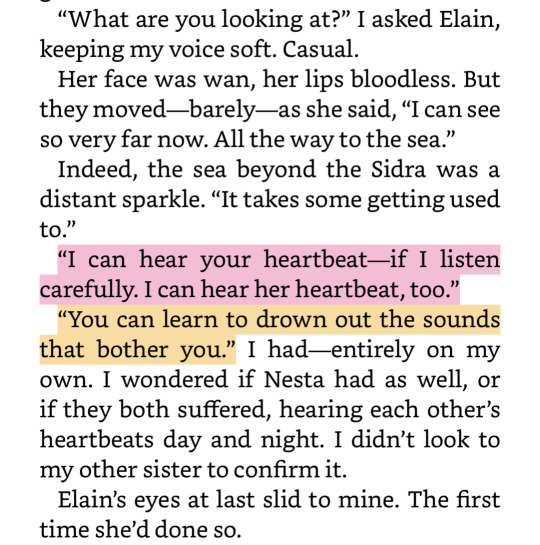
Elain can hear Feyre's heartbeat. She says if she listens carefully, she can hear hers too. At the time, we all assumed she was talking about Nesta. And yet we've discovered that Vesperus, an Asteri, (or Valg, depending on which theory you vibe with) was also a beating heart under the stone.
Inside a glass coffin.
More than that, we have this passage:

We now know that the Prison was once the Dusk Court, and just like UTM, The Hewn City, and Ramiel, it is encapsulated in stone beneath the mountain. Within the stone of the Prison lies the long buried heart of the Dusk Court. When you look back at Elain's line to Lucien, and see that she is staring out at the city, looking for answers at the heart she can hear beating beneath the stone, and not Lucien, this all starts to click together in a brilliant way. And the imagery, the island having a soul nurtured and blossoming under her care, has Elain written all over it.
Now, the reason I bring up the Hewn City here is because I believe there is a reason for Elain's lifelessness and distress in the Hewn City that has nothing to do with her wearing the color black.
In HOFAS, we discover a few important things about Earth Fae. Lidia discovers in her time on Team Archives what the Earth Fae did, and what their powers were used for:
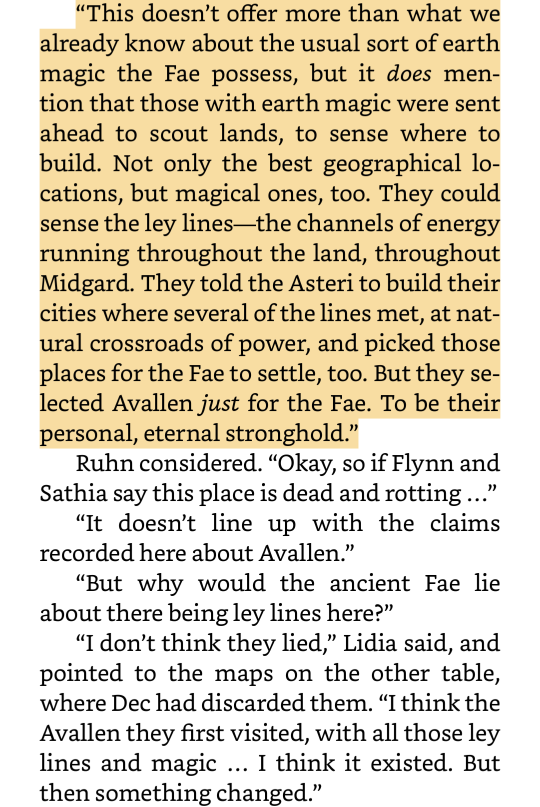
Earth Fae were used on Midgard to discover ley lines of power to create powerful strongholds. One important thing I have noticed is that all Fae on Midgard are said to come from either Erilea or Prythian (at least that is all that is mentioned) and yet there is no indicator of where the Earth Fae come from. it is my personal belief the Earth Fae are from Prythian. Yet the entire Dusk Court disappeared, and their story continued on Midgard. It is my belief that Elain is not only a Seer, but that she has also been gifted with the Earth powers that have since been lost on Prythian, priming her to both restore Earth powers on Prythian as well as the Dusk Court.
What does this have to do with the Hewn City?
Earth Fae experience distress when they are in places where the magic is dead or warped, and they are the only ones that can feel it:
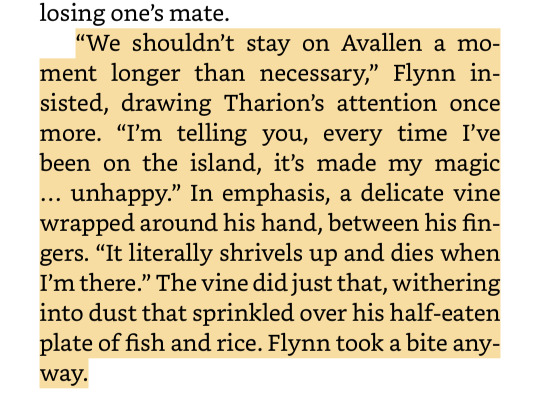
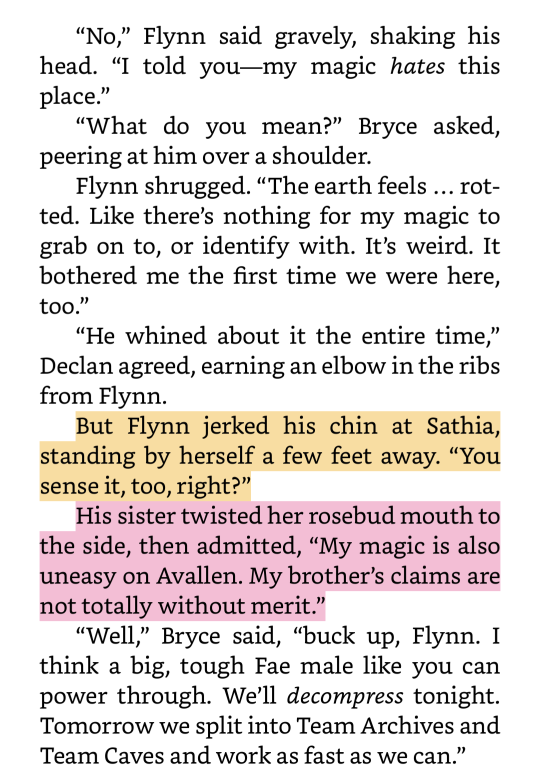
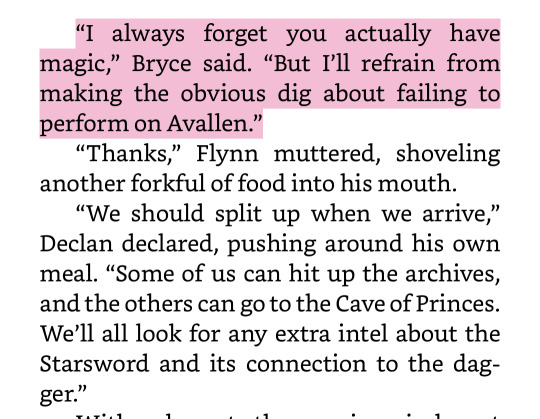
Bryce mentions she forgets the Earth Fae even have magic, because what they can do is often unseen.
If Elain is in possession of the lost Earth power, she would have been able to feel her power literally shriveling up and dying anywhere that has been warped by that magic.
And then of course we have the fact that the cave on Prythian is an exact match to the Cave of Princes on Avallen. We end HOFAS with all the weapons in the possession of the IC, the knowledge that there are cache's of magic hidden in the lands, and that there are places where the magic has been twisted and must be freed, one being the Prison/Dusk Court.
This was the imagery used once the magic was freed on Avallen, and it took its true, lush, blossoming form:
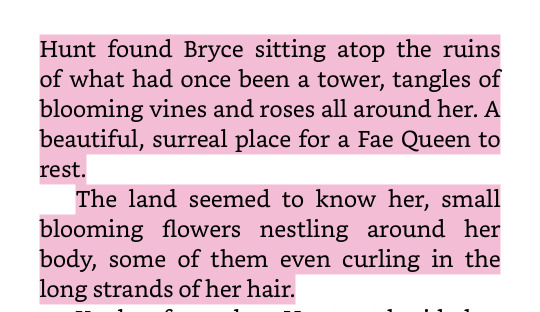
If what is true on Avallen will also be true once the Dusk Court is freed on Prythian, answer this question honestly: When you read this imagery- blooming vines and roses, beautiful and surreal, the land seeming to know her, small blooming flowers nestling around her body and in her hair- who do you think of? Who could this possibly be alluding to back in Prythian?
Elain's coding was all over HOFAS, and Azriel's "what if the Cauldron was wrong storyline" continued. These statements are true, even if none of my theories about her being an Earth Fae are right, though I know I'm not the only one who believes that is where we are headed!
The fact that The Glass Coffin is Sleeping Beauty, and that Azriel listened to it, may not be a powerful statement on its own (though I think it is). But the fact that the Cauldron corruption was revealed, and The Glass Coffin is a story of a woman who was entrapped due to her rejecting a proposal forced by magic, and Sarah used the Glass Coffin again with Vesperus, potentially tying her back to the heartbeat Elain can hear if she listens closely, it's all just too much to ignore.
I was personally overwhelmed by all of the Elain and Azriel nods in HOFAS. I think they get buried under all of the criticism in the book. I am so excited to see where everything goes, and I hope you had fun going down this rabbit hole with me!
169 notes
·
View notes
Text
Problem #6: for a movie called “The Nutcracker and The Four Realms,” it really doesn’t show us much of said four realms. The most we get is almost entirely contained within that expositional montage I mentioned earlier. Way to worldbuild, movie.
Eh it’s been four years since I’ve talked about it, anyone wanna hear about my intense and visceral hatred for Disney’s live-action Nutcracker?
#analysis#more to come later#also I completely missed this until just now but#the real-world portions of the movie are set in England? for some reason??#why#it’s not an English story#the book was Prussian and the ballet was Russian#seriously though what a waste of Morgan Freeman#and what a waste of Misty Copeland too!#if you were gonna bring on such a well-known dancer in the ballet community you should’ve given her a role with ANY significance!
37 notes
·
View notes
Text
Right I know I said I wasn't going to go all deep and analytical with Abigail (2024) buuuuuuut I want to talk about the ballet music choice.
Tchaikovsky's Swan Lake tells the story of a young woman who got cursed by an evil sorcerer to turn into a swan during the day. Abigail was turned into a vampire by her 'father' and therefore can't go out during the day. There's also a common theme of the power of love and compassion triumphing over selfish dark deeds.
Also, y'know, the 1931 Dracula film used the 'Swan Lake' theme during the opening credits... yeah it was more likely (translation - it was EXACTLY for that connection, oh my god, why am I like this??) chosen for 'Abigail' because of that connection.
So, I wouldn't be surprised if my "hang on.." analysis is just pure coincidence, but it's a nice coincidence if that's the case. Either way, I always love hearing this score :)
*please PLEASE don't read this and think "oh ok so Abigail is a dark, complex psychological thriller?" noooo no no no no - it is very much a silly, fun, bonkers vampire comedy, but it's also got some heart to it, too... and not just the ones exploding.
120 notes
·
View notes
Text
One of the most fascinating pieces of movie analysis I've ever read is J.B. Kaufman's thesis of the "two different Snow Whites" in Disney's Snow White and the Seven Dwarfs.
He writes about this in both of his two books on the making of the movie, The Fairest One of All and its companion piece Snow White and the Seven Dwarfs: The Art and Creation. His argument is that Snow White's two leading animators, Hamilton Luske and Grim Natwick, each gave Snow White a slightly different personality when they drew her. A close look at the movie, and knowledge of who animated which moments, reveals subtle differences in Snow White's expressions and body language. Luske, her head animator who handled the majority of her scenes, portrayed her as a more purely innocent, childlike character, while Natwick, the creator of Betty Boop, gave her a little more maturity, sophistication, and sauciness.
You can see the difference, for example, when comparing her girlish interactions with the animals in "With a Smile and a Song" and "Whistle While You Work" (animated by Luske) to her flirtatious smiling at the Prince from the balcony, or her "mothering" of the dwarfs as she examines their dirty hands (animated by Natwick). Or her responses to Grumpy in the scene before the Washing Song: as she asks "What's the matter? Cat got your tongue?" she looks at him with a devilish grin (Natwick), but then when he sticks out his tongue at her, she reacts with the most wide-eyed, girlish shock (Luske).
Now, I don't know if these two men really held different views of Snow White's character, or if it just worked out that Luske drew Snow White's more innocent scenes while Natwick was assigned her more grown-up moments. But either way, Kaufman argues that this "tension," the movie's constant push-and-pull between "Snow White as a wide-eyed innocent girl" and "Snow White as a self-assured young woman," makes her an especially interesting Disney Princess. I tend to agree, especially because, miraculously, there's no sense of inconsistency in her character. She comes across as a young girl on the verge of womanhood, who naturally can still be naïve and childlike in some ways, but more grown-up and clever in others.
This thesis makes me wonder if certain "tensions" in other movies are the result of different viewpoints within the creative team.
For example, in Beauty and the Beast.
Linda Woolverton has often talked about her feminist goals in writing Belle's character, which sometimes clashed with her collaborators' visions of Belle as a more traditional fairy tale heroine. It just might have been those clashing viewpoints that created the dichotomy in Belle that I personally think makes her interesting. On the one hand, she's a strong-willed misfit rebel, partly inspired by Jo March in Little Women and by Katharine Hepburn's screwball comedy heroines, who longs for adventure, isn't looking for romance until she unexpectedly finds it, stands up to men (and beasts) who abuse their power, and refuses to let anyone dominate her. On the other hand, she's a sensitive dreamer with delicate beauty and balletic grace, who wears pretty, ladylike dresses, adores fairy tales and love stories, and is sweet, nurturing, and almost motherly to her friends and loved ones. Yet somehow these two sides of her character co-exist with no sense of inconsistency between them.
There's also the dichotomy between the two different views of the Beast that the movie seems to present at once. On the one hand, there's the Beast as an unseemly brute, who's beastly form is both a just punishment for his flawed character and an outward symbol of it, and who needs to be "tamed" into proper "human" behavior, culminating in his physically turning human again. On the other hand, there's the Beast as a suffering, self-loathing outcast, unfairly hated, feared, and dehumanized, whose plight under the spell can easily be read as an AIDS allegory, and who needs to be accepted and loved as he is. I suspect that this also stems from different goals and viewpoints in the creative team. (For example, Howard Ashman's clash with the directors over whether the Prince should be a child or a man in the prologue – the former would have made him more "tragic" but the latter makes his punishment more "fair.")
I'd like to read an analysis of these "tensions" similar to Kaufman's analysis of the "two different Snow Whites."
#disney#snow white and the seven dwarfs#snow white#j.b. kaufman#beauty and the beast#belle#the beast#animated film#analysis#characterization#dichotomy
120 notes
·
View notes
Text
✨Little S2 Musical Analysis✨
You guys remember when Aziraphale forgives Maggie's debt in the first episode in exchange for some records?
Those records are by none other than Russian composer Dmitri Shostakovich and I know LOTS about this man (and why the choice to include him may have something to do with Aziraphale's character arc in s3!)...
Shostakovich's life is usually characterised by his tricky relationship with Stalin. During the 30s, the musical freedom enjoyed by Russian composers came to an end, Stalin clearly preferring more traditional classical music. Although Shostakovich had been criticised for his more adventurous works in the late 20s, his 1936 ballet, Lady Macbeth of Mstsensk got him officially denounced by Stalin's official newspaper (Pravda).
Composers who refused to comply with the standards were denounced as formalists (including Western elements in their art) and risked deportation to a remote area of Russia, imprisonment and even death.
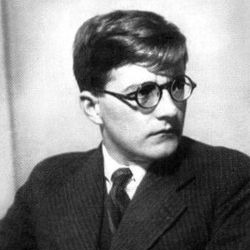
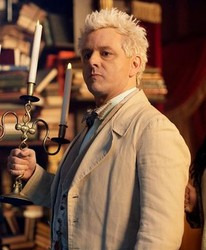
On to the record in question! The Symphony No. 5 was written after this denunciation. It was a success, being to Stalin's liking and praised as a "Soviet artist's practical and creative response to just criticism". Shostakovich was back in Stalin's good books.
Who else do we know to be once denounced and hated by a regime who has just recently got back into their good books?

This might just be a neat reference to Shostakovich's life in comparison to Aziraphale's, but Shostakovich's story doesn't end there: In 1948 he was denounced a second time for his Symphony No. 9, which was promised to be large and triumphant to celebrate the USSR's victory in WWII, but was completely the opposite - playful and cheery, mocking Stalin.
The second denunciation was in a way more serious than the first. Shostakovich (and other composers who were accused of formalism) were made to give quite a public apology. Many of his works were banned and he was expelled from the Leningrad Conservatory.
Although he was put to use again by the government in 1949 at a New York press conference, it had been remarked upon by Nabokov that Shostakovich was "not a free man, but an obedient tool of his government." Even after Stalin's death, Shostakovich still had a strained relationship with the government. They still largely controlled art and in 1960, Shostakovich was devasted when he joined the communist party.
Of course, all of this information could be completely irrelevant and it could just be Aziraphale buying some classical music. especially because the Symphony No. 5 is NOT 21 minutes long like Aziraphale implies (in fact, it's a little over an hour). But so much of this media is intentional and the PARALLELS are insane.
The second denunciation could mean a whole lot for season 3. Aziraphale is probably likely to 'go along' at first with Heaven (Shostakovich wasn't really on board with the heroic nature of his symphonies - the 5th, according to one musicologist, is a love symphony), but might be plotting something. This second denunciation appears like it could be entertaining.

What's more! Shostakovich also had a best friend who died before they could have their post-war reunion (as Shostakovich talked about it his letters). Honestly the whole thing's really tragic and hurts to think about; Shostakovich promised he'd never write another note again after his friend's death, but instead wrote his incredibly painful Piano Trio No. 2.
✨Anyway hoped you liked that✨
tagging @neil-gaiman bc why not?
#good omens#good omens 2#good omens season 2#good omens 2 spoilers#aziraphale#crowley#aziraphale x crowley#good omens season 3#good omens theory#good omens thoughts#good omens spoilers#good omens shitpost#go2#neil gaiman#shostakovich#classical music#classical composers
125 notes
·
View notes
Text
Collage box collection
After discovering that I had a reasonably big stash of interesting flyers, greetings cards, guidebooks and other bits of ephemera, and seeing this tutorial, I was really inspired to use it all for something.
This was helped by the fact that recently I've found a lot of really nice wooden boxes in charity shops for very cheap - all the ones pictured here were £2. Either I've been extremely lucky, or these things turn up very often and I just haven't been looking for them.
I've posted about some of these previously (here and here), but they were only half done and these pictures are better! Plus there is one new one.
First was this wooden chocolate box. Before...
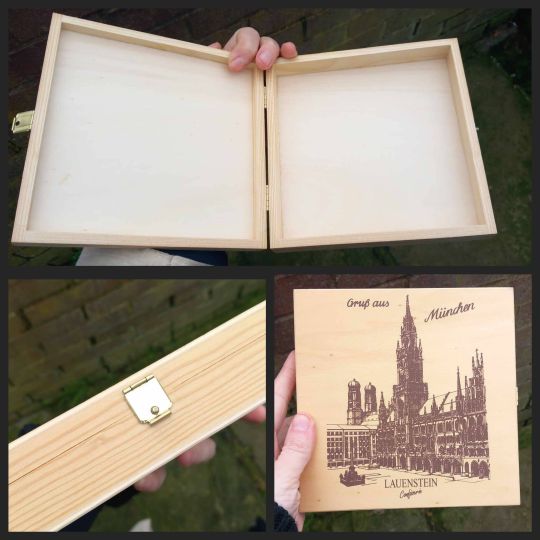
And after!
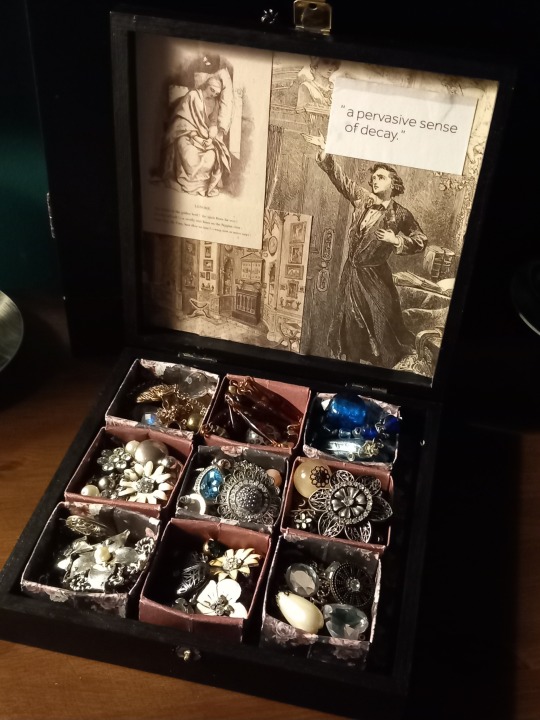
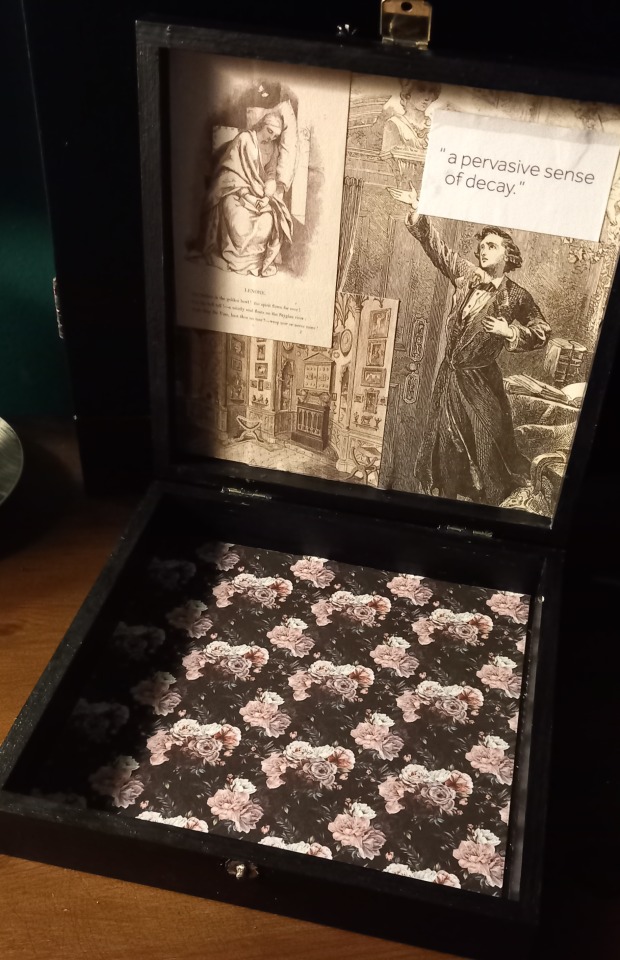

You can tell this is my first one as I oversatured the paper with Mod Podge, leading to it bubbling and creasing, but for a first attempt I don't think it's bad at all.
All the pictures I used were taken from an exhibition guide for an event I went to called "Exploring the Gothic" which contained a lot of beautiful pictures. The floral parts were from a pad of scrapbooking paper, which I also used to make the individual compartments (they are origami boxes, see a tutorial for how to make them here) and I then filled them with pieces from my collection of beads, charms, and broken jewellery.
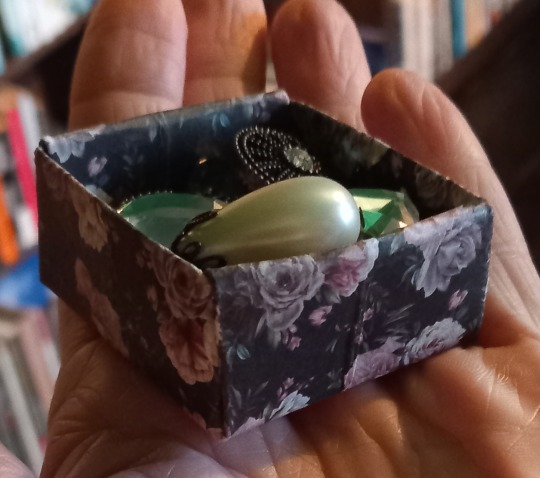
I also had a guide to a William Blake exhibition I'd been to, and since there was an entire plate from "The Marriage of Heaven and Hell" I had to make it into a miniature wall plaque.
I did this one at the same time as the first, and again you can kind of see that I oversatured the paper which caused it to tear slightly, however thankfully it wasn't in an area where there was any writing.
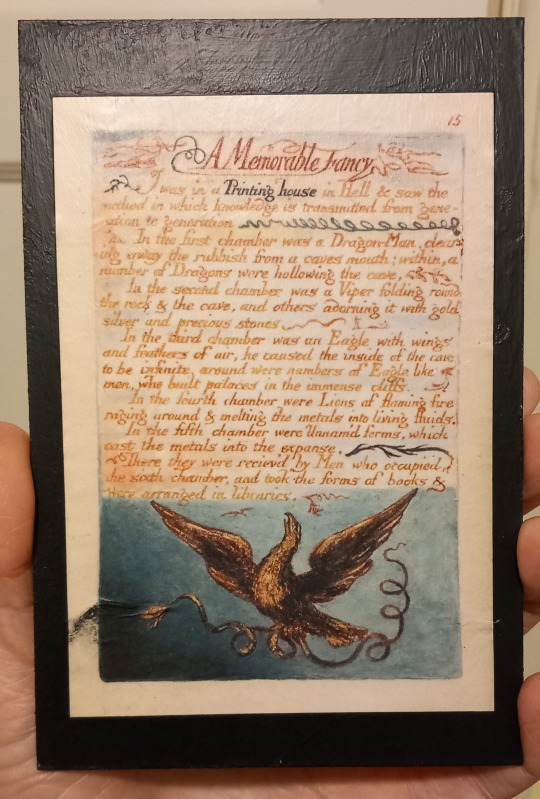
(BTW, if anyone is interested in the meaning of this section, Blake is describing his creative process, albeit in a fantastical way. This blog post gives a good analysis)
The next one was a beautiful little cabinet with a broken handle.

And here is what I did with it. I kept the collaging to a minimum, only on the inside, though I might add something to the outside in the future. The replacement "handles" are a pair of my earrings!
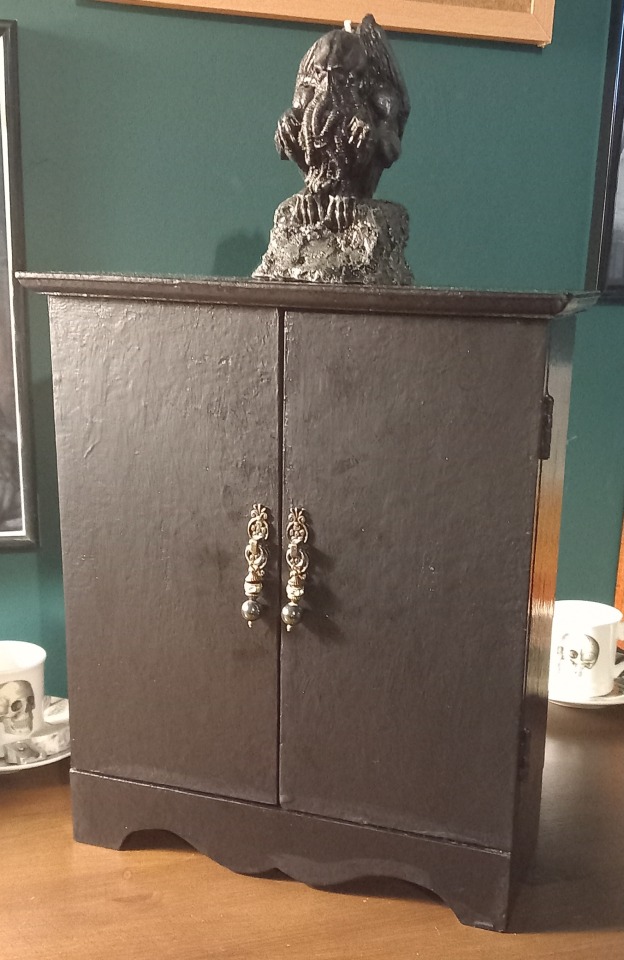
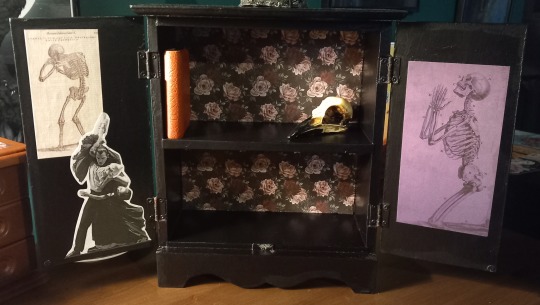
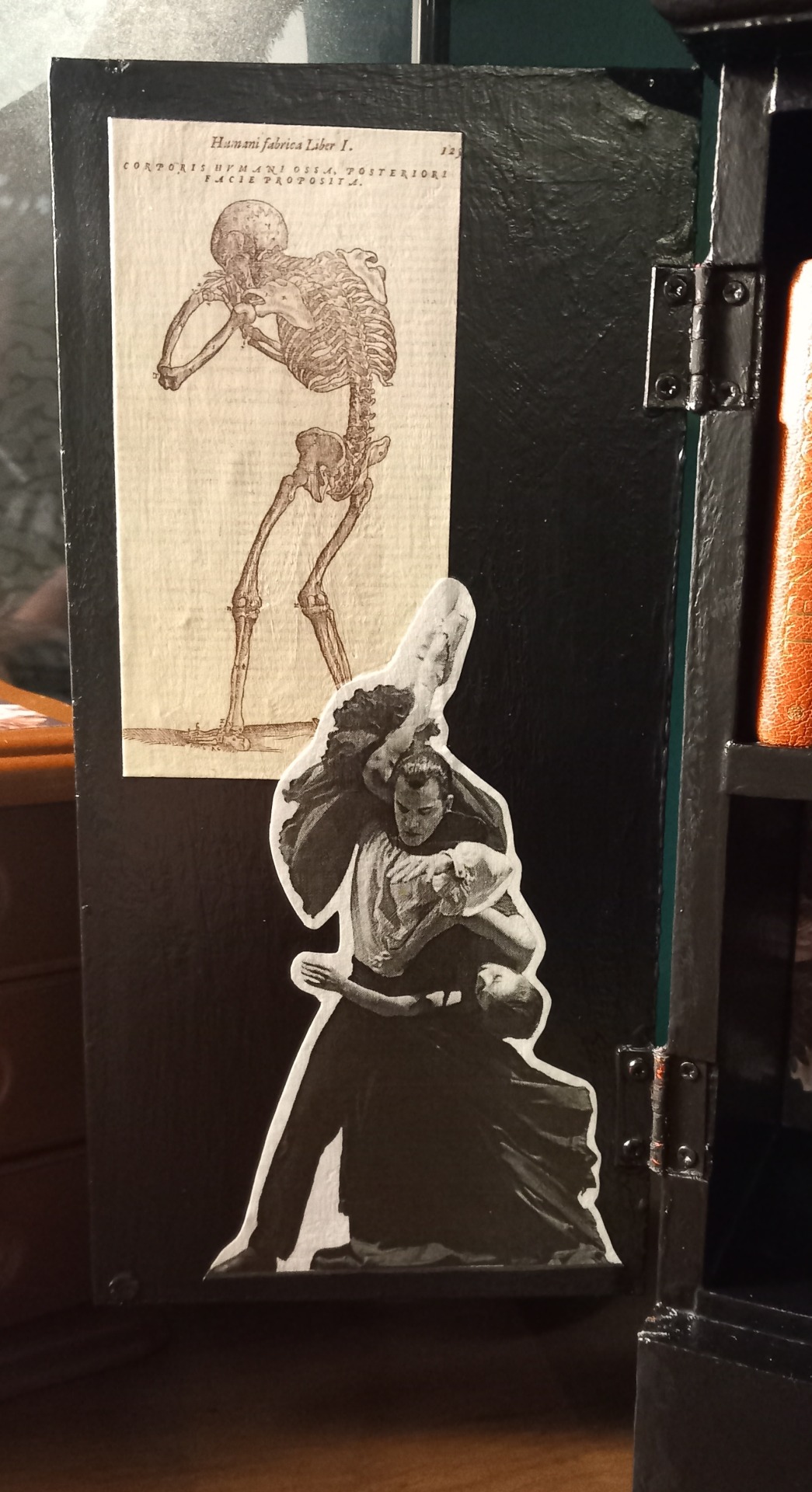
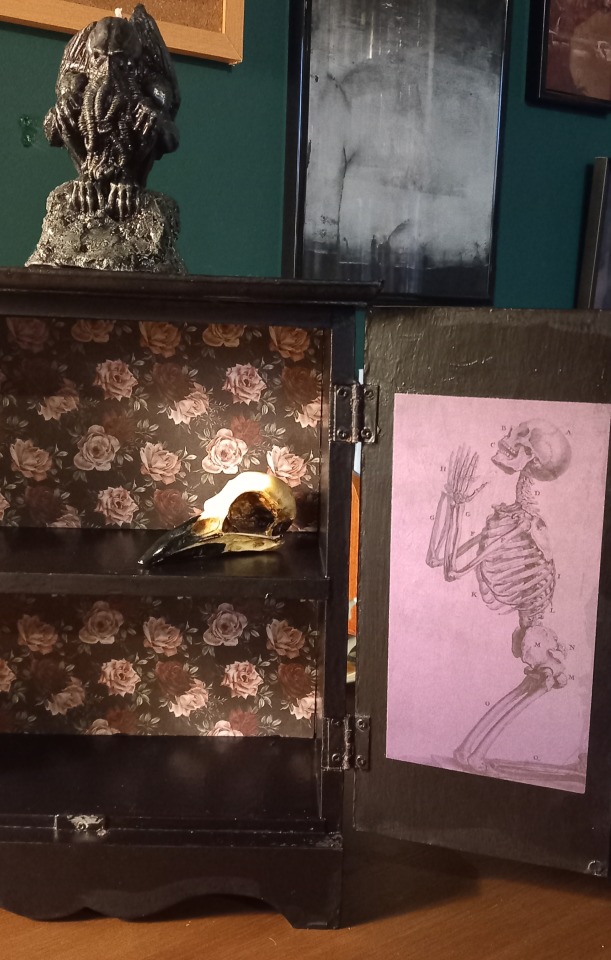
I used some more of the gothic exhibition guide and scrapbook paper, and also a flyer for a ballet version of Dracula. I need to find some more interesting things to fill it as it currently only contains my resin crow's skull and a miniature book of Tennyson poems. Also my Cthulhu candle gets to sit on top and be worshipped by the skeleton on the right door.
I did much better with the collaging process on this one. I was a lot more patient, used less Mod Podge for each layer and allowed them to dry fully in between, resulting in no tears, bubbles or creasing.
The final and most recent is this plain box. I noticed it originally came from somewhere called "Palmyra Hardware" which instantly made me think of the Palmyra Wolves (I'm a fan of MrBallen and saw him tell the story on his YouTube channel) which gives a pleasantly creepy angle to this one before I even did anything to it!

After collaging
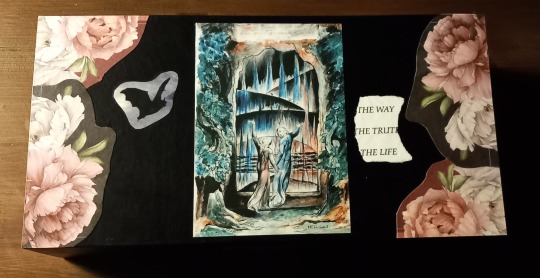

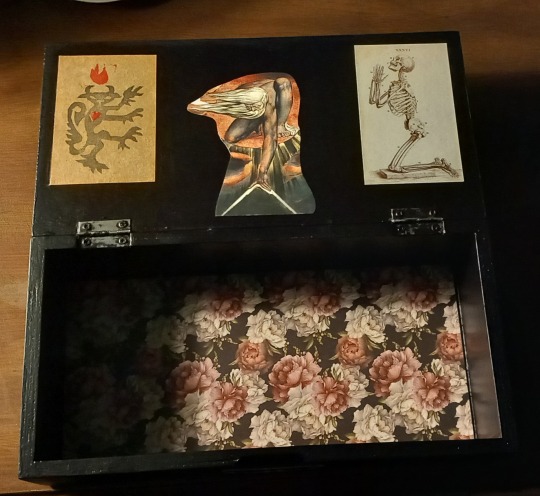
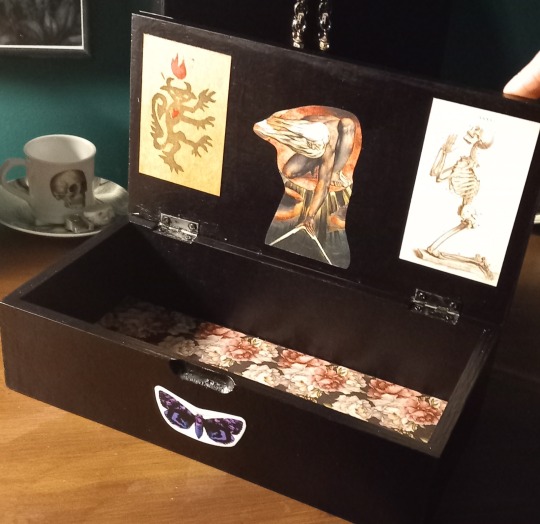
The central image on the outside is another William Blake painting, an illustration to Dante's Inferno, which includes the famous quote "Abandon All Hope, Ye Who Enter Here". The writing saying "The way, the truth, the life" came from a religious leaflet that a friend of mine was forcibly given, and which he ripped to shreds, but I saved this part because for some reason I liked it.
Inside we've got a very famous Blake painting called "The Ancient of Days", the praying skeleton again as this image was reproduced several times in that guidebook, and a block printed demon from a handmade birthday card that a friend gave me several years ago. I'm very pleased to have finally been able to use him for something!
I've enjoyed making all of these immensely and no doubt I will do more in the future as I collect more papers and find more nice boxes 😊
#collage#paper art#paper craft#decoupage#mod podge#goth diy#gothic#goth#gothic art#andreas vesalius#anatomical drawing#william blake#the marriage of heaven and hell#charity shop finds#thrifting finds#hand crafted#crafting#crowcore#corvidcore#ephemera#shiny things#shinies#origami#goth aesthetic#diy craft
30 notes
·
View notes
Text
personal take on urchoux (more like analysis)
first of all, the damn game wont let me do any quests even though it's clearly stated that you're supposed to able find them daily on the bulletin bord
and secondly, this is written in the first part of the update and theres no dynamic that we can really discuss other than we have a bad boy x good girl theme (but yuri) going on for them
in cookie run, the devs tend to stick to cookies that have similar theming in some way (if theyre releasing spicy cookies, then they arent going to have sweet-themed cookies to go alongside in the update)
*before you say "what about the tri-cone cookies", that update was literally on purpose to highlight different academy students
but overall, the team tends to always prefer having a pair of cookies that have some sort of common ground even if they have opposite personalities (ex: currant cream and pastel meringue are clearly two opposite aesthetics, but their middle ground is in fashion designing)
anyways, let's talk about the new cookies in kingdom; theyre clearly designed to fit the 'good girl x bad boy' theme, "he was a punk, she did ballet" theme, the 'prep x delinquent' theme (you get the point)
but then you see their namesake foods
normally you'd expect more of 'sour vs sweet' or 'bitter x sweet' foods to compliment the theme of their relationship, but we got
seafood x sweet
it seems like such an odd combination, but we're gonna make it a more deeper than this
first off, the ingredient/food theme street urchin and caramel choux have is actually based off high class delicacies
while caramel choux could just be a caramel dipped cream puff, she could have been inspired by croquembouche

on the other end, despite street urchin's reputation as biker, the actual sea urchin is a gourmet dish that can only be found in high-end sushi restaurants (but it has become popular in europe as well because they like fancy food)

in a nutshell, street urchin and caramel choux are both meant to be inspired by these high class foods (and that checks out??) rather than it sounding like 'what if a seafood and pastry kissed' (okay that sounded funnier than it should be)
but honestly it would a really interesting concept if the story writers didn't use them for the town square setting and instead developed them be more like their respective dishes and have more refined designs for them (aka have them in extravagant, legendary costumes you can find in ovenbreak)
would personally love to see a wedding planner costume for choux and a badass sukeban costume for street urchin
17 notes
·
View notes
Note
I watched ATSV again in theaters and noticed some interesting things:
Gwen's dad at the beginning wears a Vision Academy sweater. Not only that, he's in the gymnastics group. This means that Vision not only exists on Earth-65, George has entered it. Maybe it explains how Gwen knew how to blend in so well. And that she chose to take ballet lessons because of her father.
When Miguel's universe was falling apart, not only he but Peter B. and other spiders were there. It gives extra weight to the whole Society thing. It's not just a sad story a random guy told, it was a catastrophe witnessed by several of them. I don't blame them for believing so much.
Peter and Gwen have known each other since they were 4, assuming she's 16 and George's speech after his death says he's known Peter for 12 years.
A spider person having their Sense Triggered when someone they love is not themselves in danger is not new. Miles felt his father falling at the beginning of the film. Pav felt Gayatri on the bus. But what is abysmal is that Gwen's felt between dimensions. In all other cases, they were from people present in the same space and dimension. So that says a lot only about the love she feels for Miles (and also about her spider sense.)
Oh these are interesting!
I actually notice that shirt on my last viewing! I cannot believe it took me this long to realize.
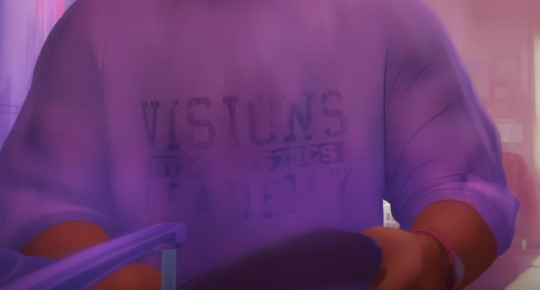
Funnily enough, my first thought when I saw this is that Gwen was Vision's and this was a shirt in support of her. But considering how faded this looks, your explanation makes more sense since I really doubt Visions Academy has lower classes than middle school.
Though not gonna lie, I found funny the idea that the visions in Gwen's world may be just another run-of-the-mill school, just to appear in Miles's world and be like "why did he get the nice version?"
May keep that hc regardless.
Oh I knew Peter was there from the first viewing, what I didn't realize was about the different spiders!
Let's see who he can spot.
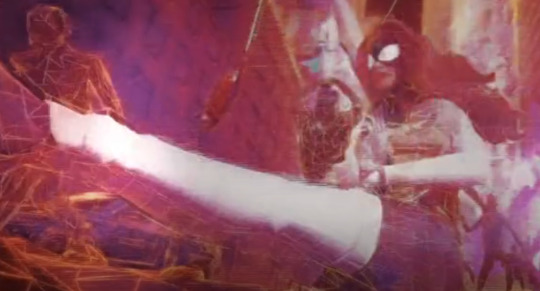
Julia Carpenter is here! I am not really familiar with her character (I don't read comics, for now at least,) but hey, nice to see they are bringing some classics.


I'm going to assume this is Peter B, but I don't think anyone can blame me for mixing this one up if it isn't the case.

Cowboy Spidey is here!

This one we are going to wait for the HD version of this movie because I had a hard time finding a frame where I could kind of see them let alone be clear who they are.
I still need to finish that analysis, but honestly the organization as a whole works in some ways that upon reflection, not only I am not surprised they believe it, I'm more than anything horrified how no one realized how nuts the place was getting.
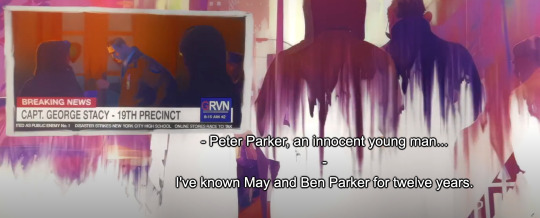
Good eye! I haven't noticed this one myself, and again, I had seen this movie several times. In my defense, sometimes the audio is hard to catch and I had issues catching stuff at it is. I really need to get a good version of this movie with subtitles.
But this is cool! It really goes to show how important was Peter for Gwen, they really had known each other since forever and I can't imagine not just how much it hurt Gwen losing Peter, but her needing to get used to reality of not having around after doing so for so much of her life.
Goddammit when I thought Peter and Gwen's tragedy couldn't get worse-
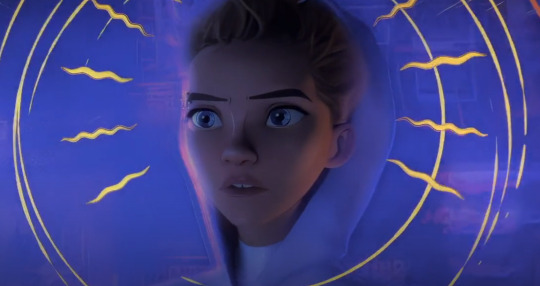
This one y'all know how I feel, and if you don't, here.
I still hope we get a more in depth explanation, though I wouldn't be surprised if we don't. Regardless, is undeniable how much Miles matters to Gwen, and viceversa.
Thanks for telling me this!
#ghostflower files#atsv files#gwen stacy#george stacy#peter b parker#ask#across the spiderverse#atsv
62 notes
·
View notes
Text
The Strategic Ballet of SEO Consulting: Crafting Digital Excellence

In the intricate ballet of the digital landscape, SEO consulting emerges as a choreographer, gracefully navigating the complexities to elevate businesses to new heights. This blog unveils the artistry behind SEO Consultant Services, exploring the nuanced dance between technical precision, content finesse, and the harmonious link-building that defines their unique approach to digital optimization.
Setting the Stage: SEO Consulting Beyond Conventional Wisdom
Decoding the Essence of SEO Consulting:
Beyond the common narrative of SEO as a means to visibility, SEO consultants are akin to creative directors shaping a narrative. They delve into the essence of a business, understanding its brand story, goals, and aspirations. SEO consulting is not a formulaic process; it's a choreography tailored to showcase the uniqueness of each business.
Strategic Choreography:
SEO consultants don't believe in off-the-rack solutions. Instead, they engage in a strategic choreography, conducting a thorough analysis of a business's digital footprint. This forms the basis for a customized dance, aligning SEO efforts with the specific needs and objectives of the business.
Unveiling the Choreography of SEO Consulting
1. Technical Ballet:
SEO consultants showcase their prowess in the technical ballet of website optimization. From streamlining site structures to ensuring seamless mobile experiences, their technical finesse lays the foundation for enhanced user experiences and improved search engine rankings.
2. Content Waltz:
In the graceful waltz of SEO, content takes center stage. SEO consultants curate a narrative that transcends mere keywords, focusing on creating a dance of information and engagement. Each piece of content is a step in the ballet, designed to resonate with the audience and lead them to conversion.
3. Link-Building Pas de Deux:
Similar to a pas de deux in ballet, SEO consultants engage in a delicate dance of link-building. They cultivate relationships with authoritative websites, earning high-quality backlinks that lend credibility to a business's online presence. It's a strategic dance that contributes to higher search rankings.
The Artistry of SEO Consulting
1. Adapting to the Digital Rhythm:
The digital landscape is a dynamic rhythm, ever-changing and evolving. SEO consultants are choreographers in tune with the latest beats, adapting their strategies to the nuances of evolving search engine algorithms. This flexibility ensures businesses dance seamlessly with industry trends.
2. Transparent Choreography:
SEO consulting is not a mysterious dance. Unlike performers guarding secrets, SEO consultants believe in transparent communication. They demystify the intricacies of SEO for businesses, fostering collaboration and ensuring clients actively participate in the choreography of optimization.
The Crescendo of Impact
1. Amplifying Visibility with Elegance:
SEO consultants orchestrate a crescendo of visibility with elegance. Through strategic optimization, they ensure businesses stand out in the vast expanse of search results, capturing the attention of their target audience with finesse and maximizing visibility.
2. Sustained Applause of Growth:
Beyond the immediate applause of improved rankings, SEO consultants focus on the sustained ovation of growth. Their strategies not only attract visitors but cultivate long-term relationships, transforming casual clicks into devoted patrons of a business's performance.
In Harmony with Success
As businesses pirouette through the digital ballet, the expertise of SEO Consultant Services emerges as a guiding choreography. Their ability to craft unique strategies, dance through technical intricacies, and adapt to the ever-changing digital rhythm positions SEO consultants as choreographers in the art of online optimization. In a world where online presence is the grand stage, SEO consulting becomes not just a service but a transformative dance orchestrating businesses toward the crescendo of digital success.
20 notes
·
View notes
Note
Looking for an anime to watch. What magical girl series would you recommend?
I will always say Sailor Moon, so Sailor Moon.
Pretty Guardian Sailor Moon, the live action Sailor Moon sentai show is incredible despite having a budget of $5 an episode. And I HIGHLY recommend it.

Card Captor Sakura is a lot more lighthearted but I still recommend it because it's still enjoyable if you're older than 8

Full Moon Wo Sagashite is a Magical Girl show where our main character is an idol, not a crime fighter. But I find it to be one of the best magical girl shows I've watched outside of Sailor Moon. It deals with terminal illness, the business side of the idol industry, lifetime goals and how we have to accept when life itself gets in the way of those dreams, loss, and doing your best for yourself most of all.

Princess Tutu. Do you like narrative deconstructions on the nature of fiction? Sure you do! Also ballet.

The first Madoka Magica series. THE "grimdark magical girl" anime. But despite this it still has a message of hope and friendship in the face of impossible odds.

'Revolutionary Girl Utena if you feel like frying your brain trying to keep up with the in depth symbolic language of the story, human psychology, deconstruction of gender roles, the cycle of abuse, and you don't mind opening up http://ohtori.nu/analysis/ after every episode to read hefty analysis papers written by psychology students on wtf you just watched. It's my favourite anime. It's great.
(also you get to see where most current cartoons stole all their visuals/ideas from)

Wow. people who make stimboard posts have really fucked up the gif search function beyond repair, huh? >_> thanks guys.
78 notes
·
View notes
Text
Beauty and the Beast on the 18th century stage
A long time ago I promised you a handful of articles - and today it is time! I will begin with an article written by Catherine Ramond for the "Féeries" journal ("Féeries" is THE reference journal-review for all fairytale study and analysis), about the various theater adaptations of "Beauty and the Beast" in the 18th century France. As I also said before I won't do a literal translation, but rather "info-mine" as some like to say.
In the 18th century, every time a novel or short story had a huge success it was adapted to the stage, and so the fairytale did not escape. Ever since Charles Perrault and madame d'Aulnoy published their fairy stories, the "fairytale" had been a fashionable genre, and it offered to theaters a lot of material, especially since it craved magic and wonders. The story of "Beauty and the Beast" (La Belle et la Bête) especially had a lot of dramatic and scenic potential - as such the article compares FIVE different variations of the tale. Two of them are of course, the two literary versions of the tale, its two publications.
On one side, Madame Leprince de Beaumont's 1756 Beauty and the Beast, published in her "Le Magasin des enfants" (The Children's shop), THE most famous version of the story, and the one Cocteau used for his movie adaptation. On the other side, the ACTUAL first written/literary version of "Beauty and the Beast" titled as such, the one Leprince de Beaumont actually rewrote for her own book: Gabrielle de Villeneuve's Beauty and the Beast, inserted in her 1740 novel "La Jeune Américaine et les contes marins" (The Young American Girl and the sea tales). While this story was definitively "modern" in style and shape, it borrowed folkloric motifs (such as the theme of the animal-husband), making it a "cousin" to several of madame d'Aulnoy's fairytales (Serpentin Vert, The Green Snake ; Le Prince Marcassin, The Boar Prince), as well as a descendant of the model from Antiquity: Psyche's tale from Apuleus' Metamorphosis. This link between the new and ancient tale might have inspired the adaptators, since the tale of Psyche had been heavily adapted throughout the 17th century in different genres. 1656's Benserade and Lully's Psyche Ballet ; Corneille-Quinault-Molière-Lully's 1671's Psyche tragedy-abllet ; Corneille (Thomas this time)-Fontenelle-Lully's 1678's lyrical tragedy Psyche, etc etc... What we do know for sure is that the writers of fairytales and creators of stage entertainment of the time were well aware of the key elements of the story: Psyche's inhuman beauty, the oracle that offers her to a hideous monster, the jealousy of her sisters that causes bad advice (notably their encouragment to see the invisible husband despite it being forbidden). However... Against a Psyche perceived as a flaed character, against this weak, naive, curious Psyche, the 18th century opposes Belle, a Beauty who is kind and brave, and who instead of disrupting the order re-establishes a balance between the characters. The prince, turned into a Beast because of a spell must, to regain his true shape, have a young girl falling in love with him despite his horrible appearance. When Belle confesses her love and agrees to marry Beast, it makes the "beautiful Unknown" that she saw in her dreams appear before her, a Prince "more beautiful than love". This story reunites magic with a family drama (the relationships between Belle, her father and her sisters are at the forefornt of the narrative), while addng emotion and virtue: the fairytale had all the elements that would attract stage-writers and directors of the century.
The first "féerie dramatique", the first stage adaptation of this story was actually released between the two literary versions of the tale. It was the 1742's three-act versified comedy by Nivelle de La Chaussée "Amour pour amour" (Love for love), that borrowed elements from the very recent madame de Villeneuve's story (1740). The two last theater adaptations of the story were created after madame Leprince de Beaumont published her tale, and take inspiration from it. One is the ballet-comedy in four acts by Marmontel, with a music by Grétry, "Zémire et Azor" (names borrowed from Nivelle de La Chaussée). It had a huge success in 1771 when it was presented first at Fontainebleau, than at Paris. The second is a two-act prose comedy by madame de Genlis, "La Belle et la Bête", published in 1779 in her "Théâtre à l'usage des jeunes personnes" (Theater for young people). This play was for private stages, and had an open goal of educating children, by accentuating the moral aspect of the Leprince de Beaumont's tale. These adaptations truly show the wide variety of genres that welcomed the fairytale: a "classical" comedy, an "opéra-comique", and a small "moral treaty in action" for the theaters "de société".
The article wonders which elements of the fairytale were kept in theaters, and which ones were modified. There is also a brief recap of all the elements that encourage differences. For example, the fairytales are told through a third-person narraton, as opposed to the plays that need the characters to speak for themselves at the first person. Or how the literary fairytales are influenced by their context. Madame de Villeneuve's story was inserted in a novel, a "roman" as we call them in France, and as such her fairytale has "romanesque" aspects to it - for example by having inserted stories within the main story, which was a typical novel-device of the time. As such, when the Prince can freely speak again, he tells his own past through the sub-story "L'Histoire de la Bête", then followed by the sub-story of "The tale of the happy island" which unveils Beauty's true identity as the secret daughter of a King and a Fairy. The main story itself is divided in a double time: on one side the diurnal scenes, when Beauty and the Beast encounter each other, on the other side the nocturnal scenes, when Belle dreams of Le Bel Inconnu, which is the Prince. This dream-part of the tale will be heavily reduced, if not completely erased, in the other texts, while the two sub-stories evoked above will be removed from both the stage-adaptations and Leprince de Beaumont's rewrite. Beaumont's version is a simplified and linear tale, with its own context - a pedagogical one. Her "Le Magasin des enfants" is a dialogue between the figure of a "wise governess/knowledgeable nurse", and her most brilliant and obedient students - as such the fairytale is introduced, then commented, as a tale the children should study and find a message within. The narration itself multiplies the elements revealing it is the story told to children, such as this sentence "The beauty (because I told you before it was the name of the youth), so, the beauty, I said". This pedagogical nature, just like the romanesque overflow of the first literary tale, was removed by theater adaptations. When it reaches the stage, the tale only remains as what stuck in memories, as a pure fairy-story, which allows for its multiple metamorphosis and readaptations. Jean-Paul Sermain wrote about this in his book studying fairytales and concluded that, if a fairytale wanted to stay alive, it needed to escape its own context. This is clearly what happened with Beauty and the Beast.
And Leprince de Beaumont had already greatly helped the dramaturgists, by removing the romanesque elements of Villeneuve. Marmontel heavily used this to his advantage, with an adaptation very close to the tale - in fact, one of the main criticism against his "Zémire et Azor" was to have followed step-by-step the tale. People wrote at the time that what he did was just "Add some dialogues to a small story that isn't even his own". He was accused of "stealing" from Le Magasin des Enfants, of not having a single original idea in his own production, and basically one could read the book and have seen the stage ballet. Nivelle de La Chaussée's comedy, "Amour pour Amour", is further away from the literary story, especially since only madame de Villeneuve's story could be known at the time. This is also why it is the only stage adaptation that explains the metamorphosis of Azor/Beast due to the unshared love of a fairy, who in the play takes the shape of a romantic rival named Assan. La Chaussée also took another element from Villeneuve's tale: the dream where Azor appears to Beauty in "all of his brightness". Azor, like the Beast, is doubly punished: he has a repulsive physique, and he is forbidden from expressing his love. And here is the problem: how could the innocent Zemir pronounce the words "I love you" if she doesn't hear them first in her lovers' mouth? "Amour pour Amour" is, as such, quite close to Marivaux's theaters (comparisons can be made with his 1721's Arlequin poli par l'amour, for example). Nivelle de La Chaussée also gives to the story an Oriental aspect: the story takes place in a small town near Bagdad, Beauty and the Beast are given the exotic names of Zémire and Azor (later reused by Marmontel), and the family of Beauty are replaced by "confidents", which form a couple parallel to the main heroes, as it was usual in the comedy of France - the author also used these secondary characters as a way to deal with the absence of a narrative voice.
In fact, the absence of a narration is a problem for all three stage-adaptations. Marmontel gives to the father (Sander) a slave named Ali, who brings a comical letter ; while madame de Genlis gives to her Beauty (Zirphée) a friend named Phédime who is her confident, her match-maker, and a bit of her rival. But Marie-Emmanuelle Plagol highlighted that the character of the companion is fundamentaly "foreign to the fairytale", which is supposed to be "played in solitude". Only Marmontel kept the characters of the father-sisters, and the initial episode of the rose. Madame de Genlis went further away from the story by making Zirphée an orphan girl destined to a repulsive husband, while Phanor/Beast ravished her to escape an enchantment of unknown origins. All he says about this is: "Barian Fairy! Enjoy the excess of my pain ; your power, superior to mine, condemned me once to endure life under this hdeous shape, and I can't take back my first face unless I am loved, by touching with my scary face a soul that felt nothing before". So, while there are variations, the three stage-stories borrow from the literary versions A) the two main characters B) the key plot and C) the spectacular ending tied to words that must be pronounced.
Now, despite Mme Leprince de Beaumont heavily reducing the story, it still has a length that is hard to bring on stage... Yes the events and the "coup de theatre" are perfectly dramatic, but the stage cannot render as well the slow evolution of the characters and the feeling of time passing by. It doesn't help that the three plays studied here are relatively short - two or three acts (four for Marmontel's but only because there are long songs). Beauty's stay at the Beast's castle is a large part of the story plot - but it is not very "dramatic", and the characters are usually alone during this sequence outside of their brief daily encounters. For Mme de Villeneuve, this sojourn allowed her to describe at length the luxuries and the entertainments of the magical castle while the Beast, cursed with both ugliness and stupidity, avoided Beauty's company so as to not bore or disturb her, rather hoping the wonders would replace him. As such, the magic was a temporal one, alternating the various wonders Beauty discovered with the daily meals during which the Beast appeared and asked the same question, over and over again. The scene of the meal, first described in details, became shorter and briefer with each repetition - and this repetitive nature was essential to the tale, as it shows Beauty getting accustomed and used to the Beast - paving the way for her starting to like him... But it doesn't fit theater. Mme Leprince de Beaumont does a similar thing - the ritual visit is first a full dialogue, then shortened in one or two sentences. But the same idea of the repetition becoming an habit, and the habit allowing Beauty to overcome the Beast's monstrous appearance, remains. How can it be translated on stage?
Nivelle de La Chaussée, who only wrote two interactions between Azor and Zémire, delegates the descriptions of Zémire's growing love to the characters of the confidents. Azor describes to Zaleg how Zémire is getting accustomed to him in the very first scene ; and later insists on their daily encounters when talking to Nadine in scene 5. The slowness of Zémire's love does not come from the horror Azor causes her, but rather of her own ignorance of what love is: when Assan declares his love for Zémire, he actually helps his rival unwittingly, by allowing Zémire to discover her own love for Azor. Nivelle de La Chaussée is interested by something left obscure and undescribed in the tales: how the characters realize and understand their own feelings. Marmontel, meanwhile, synthetizes all of the daily encounters between Beauty and the Beast in one scene (III, 5) and has Zémire/Beauty say herself "Seeing you so much, my eyes got accustomed". As for Genlis, he offers three encounters between Zirphée (Beauty) and Phanor (The Beast), during which Zirphée becomes bolder and bolder. But this compression of time always causes a same phenomnon among the three authors: the appearance of the Beast is modified, to explain such a fast change in relationship. The theater-Beasts are not as repulsive as the fairytale-Beasts, their monstruosity is watered-down.
However, while all the theater adaptations compress the time-dimension of the play, it is to better highlight the spectacular of the final transformation - always done alongside a change in sets. This was the most "dramatic" lement of the fairytale, and it shows. The decisive word of the Beauty, who agrees to marry the Beast, causes the dénouement, the de-transformation of the Beast into the Prince. In the two narrative versions, the words have an immediate effects - as soon as Beauty pronounces the words, the magic operates. Of course, the theater potential of such a scene is enormous: a "key" word causing a final "coup de théâtre" - and transformations of stages and sets were very, very liked at the time. As such all three plays have a common dénouement. At Nivelle de La Chaussée, when Zémire says "Yes, it is Azor that I love", the theater turns into a woodland, a clearing of orange-trees with a cradle of flowers among which is Zémire's statue. At Marmontel's, when Zémire says "I love you, Azor, I love you..." the theater turns into an "enchanted palace" and Azor is sitting on a throne in all of his beauty. And for Mme de Genlis, when Zirphée says "Yes, Phanor, I loved you ; yes, I cannot live without you", music resonates, and Phanor appears from the back of the stage in his human form, sitting on a throne of flowers. And Azor's explanations in the various plays also all sound similar: "Yes, I am that Genie that..." "Yes, I am this dreadful monster, that you did not hate despite his ugliness". However, there is one specific change from the fairytales: in the stage-plays, Beauty just has to declare her love ; while in the original tales, she has to either agree to sleep with the Beast, or to marry him. Again, we see a sentimental and psychological shift linked to the "weakening" of the Beast, not as threatening and not as monstrous, even in what he asks of Beauty.
While the wonders of the final transformation caught the eyes of the playwright, it wasn't the case with the other magical eements of the tale... Mme de Villeneuve's castle was an "enchanted palace", filled with fireworks, wealth, singing birds and monkey-comedians. When she opened the six windows of a room, Beauty could see the plays given in the four great theaters of Paris at the time (Comédie Française, Comédie Italienne, Opéra, Foire Saint-Germain), plus a view of the Tuileries and one of the "spectacle of the world". This careful "mise en abyme" of the "theater as the world" or the "world as a stage" was not kept by stage adaptations. In the written story, they were somptuous entertainments meant to distract Beauty from her loneliness and boredom, while showing how the Beast's muteness could be compensated by immense power and infinite wealth. But again, the loneliness of a bored Beauty and the forced stupidity of the Beast were not fit for the theater. Each playwright finds a different way to replace these wonders. Nivelle de La Chaussée opposes the seduction of wealth (embodied by Azor's rival, Assan, who in truth is the fairy in disguise) and Azor's pure love, who only has flowers to offer to Beauty and prefers to be loved for himself (he is very Marivaux-like). Marmontel rather decides to mix the luxuries with the Oriental exotic: the only indication for Azor's palace is "a wealthy salon, decorated in an Oriental way. Flower-filled vases between the windows" ; Azor's appearance in the third act is preceeded by the sight of a throne of flowers rising in the middle of the room, and a dance of genies. As for Mme de Genlis, while she does take back elements from Mme Leprince de Beaumont fairytale (lots of books, lots of wealth, the clavecin), the exploration of the palace is condensed in the second scene of act III, and while it works as a temporary burst of wonders, it does not reflect a daily cohabitation.
Finally, Marmontel and Mme de Genlis reuse the magical items of Mme de Beaumont, such as the magic mirror in which Beauty saw her family. Marmontel turns it into a magical painting: the family of Beauty appears at the back of the stage, framed like a painting, Zémire can hear them but not talk to them and it all disappears when she tries to touch them. (This stage trck had a huge success). The other magical item was the ring that teleported Beauty: Marmontel links the ring with the modifications of the sets, since it allows to alternate between the father's house and Azor's palace - but Marmontel does add a cloud to transport Sander and Ali. It might be a remnant of the Zephyr that carries Psyche and the other characters of Apuleus' tale. Within Mme de Genlis' play, Phanor's powers are also embodied by the ring that conferes to Zirphée ubiquity and the power to grant wishes, but ultimately the ring will be useless. However, Zirphée finds within the ring's box the final letter of adieu of Phanor - and it is reading this letter that causes Zirphée's declaration. The magical object is replaced by a very traditional and common item of theater: the letter.
The most extraordinary, strange and fascinating element of the tale however is the Beast. This horrid, scary beast that Mme de Villeneuve describes in terms of "abominable screams, terrible noises, a furious expression, a trunk like the one of an elephant, the enormous weight of his body, scales clicking with each movement". Aurélia Gaillard highlighted that this heavy, loud, scaly elephant-like body could be interpreted as an imperious, exhuberant sexuality described in monstrous terms.Mme Leprince de Beaumont attenuates a bit the Beast's horror because he is never described - he is said to be horrible and to have a frightening voice, but the Beasts laments more about its "ugliness" than its "monstruosity" - and in fact, the Beast can become quite ridiculous, such as when, in an attempt to sigh about its own sad fate, it "whistles so loudly all the walls of the castle shook". How can this be translated on stage?
The stage-Beasts, with their strong, exotic names of "Azor" or "Phanor" have barely anything in common with Villeneuve's monster. Nivelle de La Chaussée's text must be decyphered to understand what the Beast looks like: Azor is said to have been given an "hétéroclite" face which, in this context, actually means an "aged" face. Zaleg, Azor's confident, highlights the fact Azor is an old man in these words: "If the Fairy had left us our charming traits, / I could have tolerated ; but, Lord, we look like as if / We were about to enter the season before autumn." The fact Azor's punishment is shared by Zaleg also attenuates it. Within "Zémire et Azor", the only exact physical description appears in the list of characters: "Azor, young Persian prince, in a scary but not hideous shape ; black eyebrows, a bushy beard, a thick mane, arms and legs naked but covered by a tiger-like skin, the rest of the body clothed by a vest and a rich belt ; in behavor and action, he is a nobleman." We are far, far away from the monster! In fact, the plays have to convey the Beast's scariness through acting: in Marmontel's, when Zémire first sees him she faints, and Azor laments that it was his own ugliness that caused this. In Mme de Genlis' play, since no description is offered, we only have Phanor's words ("horrible face", "repulsive appearance"), and a few acting movements (Zirphée doesn't dare look at him ; she flees when he comes near her). But he is only a monster in appearance, as he proves to be a good, generous, sensible, delicate and faithful person. In fact, Marmontel gave his Beast a beautiful voice and pleasant words - even going as far as having him sing! In fact, it is because there is a discrepancy between Azor's appearance and his speech that Zémire believes an enchantment might be at play.
These psychological (the pangs of love) and moralizing (virtue is to be loved) trends completely erase the frightening voice, and the rude manners of the book-Beast, who had been "deprived of his mind". Villeneuve's Beauty complained that she could not talk to the Beast, she lamented herself that the Beast only spoke four or five sentences to her, and always the same ; a "stupidity in speech" that contrasted with the eloquence of the Beautiful Unknown of Beauty's dreams, and that also opposed itself to the long romanesque tale the Beast, free of his curse, offered to his audience. The Beast' slow humanization came through him speaking more to Beauty, and in a more galant way, and her noting in his speech softness and sincerity. By giving the Beast eloquence from the get-go, by removing his "stupidity", the playwrights made him closer to another famous fairytale character: the Prince Riquet of Perrault's fairytales. Riquet with the tuft was, just like the Beast, cursed by fairies to be ugly until love made him handsome, but ulike the Beast he wasn't cursed with idiocy - on the contrary, his eloquence was his main tool to win hearts. Yet another play that echoes Riquet as much as "Beauty and the Beast" would be Favart's "La fée Urgèle", a "féerie" inspired by a fairytale of Voltaire: created at Fontainebleau in 1765 with a huge success, then regularly played by the Italian Comedy, it depicts the strange romance between a fairy transformed into an old woman and the knight Robert. The metamorphosis of the act IV, where, with "the sound of thunder" the miserable hut becomes a splendid palace, echoes the stage-transformations of the "Beauty and the Beast" plays. In fact, the morality sung in the end seems like a watered-down version of the "Beauty and the Beast "lesson: "You have not disdained ugliness, / You deserve to be loved by Beauty.
The Beast's monstruosity disappears alongside its very name of "Beast". Usually appearing only in the title, the Beast becomes "Azor" or "Phanor" - and it is quite a paradox to see this sonor dimension of the name "Beast" disappearing, despite this posing no problem for the stage. In the narrative versions, we only have "Beauty" and "the Beast", and the dialogues do work fine. The exotic names chosen for the character remove the ambiguity and the wordplays originally used to conceive him, humanizing the Beast even further - and firmly setting his male identity, since "la Bête" is a female-neutral name. This need to give a precise name and defined identity to theater characters seems to reflect a deeper difference when it comes to genres: the theater relies on the words of the characters, and as such has difficulties depicting bestiality, aka what is deprived of words. The rare questions asked by Mme de Villeneuve's Beast were "impertinent" question: while it can be written that the Beast rudely asks "Do you want to sleep with me?", it is harder to have the character pronounce it on stage. And yet this sexual element (greatly watered-down within Leprince de Beaumont's version) is a key feature of the fairytale type of the "animal-groom", and seems to reflect, as Bettelheim wrote, that "sexuality is an animalistic action, that only love can turn into a human relationship". The theater must focus entirely on the romance due to what it cannot show and cannot tell ; in turn, this allows us to see the great freedom of the fairytale, which can name and show a "desiring body". By making the Beast human, the theater weakens the strange and disquieting element of the tale: the relationship between the human Beauty and the monstrous Beast was unexplained and unexplainable. As Jean-Paul Sermain said, the strength of this tale relied on the silence when it comes to the amorous choice, and how inexplicable or aberrant it is. Maybe this "shadowy" part of the tale disappears because the theater-character must always explain and analyze? Fairytale characters are lonely characters, who do not offer their inner thoughts to anybody. By giving them confidents, the playwrights allow them to explain their actions. We can think of Sedaine's "Raoul Barbe bleue", in which Bluebeard explains why he killed his wives - an element unrevaled in the story. This, alongside Bluebeard being named "Raoul", works to "desenchant" the tale.
The two public plays, those of La Chaussée and Marmontel, were enormous successes. Restif de la Bretonne, a great fan of fairy tales, wrote his enthusiasm for "Zémire et Azor", and his passion for the "Magical Painting". These plays were fitting perfectly the expectations of those that went to see a comedy or opera-comique. All in all, the three stage-plays explored, each in their own way, the dramatic and scenic possibilities of the tale, wile sprinkling it with exoticism and strengthening its "lesson" aspect. Psychology and rationality dominate within these plays, going against the very spirit of the "marvelous" of the fairytale - but by twisting the tale, they played their part in its history ; through their transformations and metamorphoses, they maintained the sense of mystery, pleasure and surprise brought by these variations and extensions. Today, cinema is continuign what the theater did before. But the difficulties the adaptations had to face back then highlight the limits of each genres. The first literary version of the tale could not fit fully the stage due to its "romanesque thickness" and its complex narrative structure - and as we saw, the most drastic change brought by the shift to the stage is the Beast, who becomes a new avatar of "Riquet with the tuft", an ugly but virtuous candidate for love. And moral as well as historial constraints forced the playwrights to remove the monstrous, the stupid, the loud, the sound and the fury - in short, the body in all of its ugliness from the story. Instead, the plays focused on the charms of the eloquence, and on the reward of kindness and virtue.
#beauty and the beast#translation#beauty and the beast adaptation#french stuff#theater#18th century theater#french theater#fairytale theater#fairytale plays#beauty and the beast plays
8 notes
·
View notes
Text
Chess (the musical)
So Chess is a 1984 concept album and subsequent stage musical with story and lyrics by Tim Rice and music by Benny Andersson and Björn Ulvaeus from ABBA. On the surface, it is called Chess because it is about some chess grandmasters vying for the chess world championship and the woman who leaves one’s employ and enters a relationship with the other. Under the surface, the real reason it’s called Chess is that the real game of chess is the one played between the US and USSR throughout the Cold War (when it was written and set), in which the characters are all pawns being played against each other to serve the interests of the warring states.
That’s a cool concept! Definitely the sort of concept you’d come up with and think, I have to make something about this, and then you try to come up with the details. Tim Rice, apparently, has tried a whole lot of times to come up with the right details: apparently every other production of this musical tries to rewrite the plot, to the point Wikipedia has a comparison table of plot points between different productions. That’s not as in just changing little details around or cutting or adding a song here and there, like you get with many other musicals; it includes stuff like turning a plot involving two chess tournaments against two different opponents a year apart into one with just a single tournament against one opponent, flipping pivotal character decisions and motivations around completely, making the ending the exact opposite of what it was, etc. etc.
For the purposes of this post, the production we actually watched was Chess in Concert from 2008, with Adam Pascal, Josh Groban and Idina Menzel, which is heavily based on the original West End production from 1986 but with some modifications. I will be doing some character analysis rambling, but be aware that with respect to other productions half of what I have to say may just be blatantly wrong. Man, it must be a trip to be in the Chess fandom. (Hello if you’re here from the tag.)
All in all, I have extremely mixed feelings about Chess. On the one hand, I have two big, major writing problems with it that made me just not enjoy watching the full production very much. On the other hand, it has some genuinely really good interesting bits that I like a whole lot, and also there are some real banger songs. Going to be my work soundtrack for a little while, probably. Summary and lengthy complaining and rambling below.
In an alternate 1979, the chess world championships are being held in the town of Merano, Italy. American reigning champion Freddie Trumper, loosely inspired by Bobby Fischer, is widely considered the wild boy of chess for his unpredictable behaviour and aggressive personality, which he plays up for the press because there’s no such thing as bad publicity. He has a lucrative deal with a company called Global Television that broadcasts the tournament, and his contact with them, Walter, is secretly some kind of undercover CIA agent. The challenger is Anatoly Sergievsky, a mild-mannered Russian who feels increasingly trapped despite his successes, kept on a tight leash by his handlers from the government, particularly scheming political operative Molokov.
Freddie’s second (sort of a chess personal assistant) is Hungarian-born Florence Vassy, who was sent from Budapest to the UK when the Soviets invaded in 1956, when she was five years old. She has grown weary of his antics over the years and tries to persuade him to please stop making remarks like “All Soviets deserve abuse” and assaulting reporters at press conferences, but to no avail. During the tournament’s first game (the actual chess games are staged as symbolic ballet between dancers dressed in black and white and it’s pretty neat), Freddie flips the board over and walks away. (That’s what appears to be happening in the staging, at any rate, though Global Television goes on to describe it as if who flipped the board was ambiguous; hard to tell if they’re meant to be describing it in a “Who can say!” way because they’re American, or if the situation is actually meant to be more ambiguous than it looked in the staging.)
Florence arranges a meeting between the two players to talk it out, prompting Freddie to lash out about whether she’s even on his side or the side of the Soviets who invaded her country, and how her father would be ashamed of her if he were alive. By the time Florence gets to the proposed meeting, Freddie isn’t there, leaving her awkwardly alone with Anatoly, who briefly wonders if she’s working for them – I mean us (he doesn’t think of the Soviet political machine as his own side). They vent their frustrations, find each other pretty, and start to connect. Freddie finally arrives, revealing he was late because he was working out a new deal with Global Television to get them even more money for participating, and now that they’ve got that he’s perfectly happy to continue the match.
Anatoly plays masterfully and soon leads five games to one. Freddie channels his agitation at being near-beaten and jealousy at the connection he saw between Florence and Anatoly into a paranoid, misogynistic rant at her about how this is what she wanted all along and it’s all because she’s a woman. She’s disgusted and quits; Freddie calls her a parasite. After a moment of angry self-pity, Freddie concedes the match altogether, leaving Anatoly the new world champion. Anatoly immediately sets out with Florence, who he has entered into a romantic relationship with, to defect to the UK to escape Soviet scrutiny.
Act II takes place a year later, at the next world championships in Bangkok, where Anatoly will be defending his title against the next Soviet challenger, a loyal Russian ‘chess-playing machine’ named Viigand. Freddie is there to commentate on the match for Global Television.
Molokov arranges to have Anatoly’s wife Svetlana, whom he left behind with their two children when he defected with Florence, sent to Bangkok to stress him out. He also secretly coordinates with Walter to get Freddie to do a barbed interview with Anatoly where he shows him video of his wife, until Anatoly storms out. Later, Walter and Molokov launch a multi-pronged plan to pressure Anatoly to just plain throw the match and return to the Soviet Union, in exchange for the USSR releasing some political prisoners. Molokov successfully threatens Svetlana into imploring him to come back, while Walter tells Florence that her father is alive in prison in Russia (something Molokov had told him) and they’ll be able to put him at the top of the list for prisoners to be returned if she persuades Anatoly to lose. Florence refuses the deal but is deeply upset, unable to let go of the thought of being able to see her father again. Walter then orders Freddie to approach Anatoly about it with a veiled threat to his employment; he does, acting all friendly, but Anatoly’s not buying it for a second. Freddie then goes to Florence instead, also apparently on their orders but trying to appeal to her based on their previous rapport instead, telling her they can work things out and imploring her to come back to him, but Florence and Anatoly are both as disgusted with him as ever, refusing his pleas.
After a dark moment of reflection about his issues, Freddie approaches Anatoly again — to help him. He’s noticed a flaw in Viigand’s strategy and implores Anatoly to win the match, for the integrity of the game and so that Walter and Molokov won’t get what they want.
Anatoly and Viigand play their final game, and in the end, Anatoly follows Freddie’s advice and wins the match like he was always capable of, in spite of how it alienates both Svetlana and Florence, because it’s the only way he can remain true to himself and retain a shred of symbolic freedom - but he decides to return to the Soviet Union anyway afterwards, to give himself up in exchange for Florence’s father. Anatoly and Florence regretfully reaffirm their love and say goodbye to each other before he leaves. Florence is left alone with Walter, who tells her they’ll get her father, if he’s still alive - oh yeah, they don’t actually know anything about that, who knows, but then again she already never knew if he was actually dead. No change there! Goodbye! (I don’t think we know whether Walter just distrusts Molokov’s information, which would be reasonable, or whether Walter is just telling her they don’t know to cover for not actually planning to bargain for her father at all.) In short, politics screwed everyone over and everything is terrible, but at least Anatoly managed to stay true enough to himself to refuse to let them fix the tournament.
My biggest problem with Chess, at least this production, is that it feels very padded; the pacing is atrocious. Based on my plot summary, do you want to take a guess at how many songs it takes for us to get to the very first chess match, the one I talked about in my second paragraph? Did you guess “Chess Game #1” being song number thirteen?
We have an entire seven-minute song about the town of Merano, Italy where the first act is set (minus a one-and-a-half-minute interlude where Freddie and Florence are introduced), sung by its anonymous inhabitants. Which would be fine, except the town of Merano and its inhabitants have no role whatsoever in the actual narrative, as evidenced by how half of the productions of this thing just casually move it to take place somewhere else entirely. The Arbiter, the tournament’s referee, gets a two-part “I am” song, despite not being a character - he narrates some things and makes a couple of brief inconsequential comments, but at no point is he as a person or his arbiter role actually relevant to anything (he doesn’t even actually arbitrate in the actual dispute that comes up), so why do we need to spend a song on that? We have a full song devoted to all the merchandise for the tournament, which I guess makes a point about the marketing of the whole thing but that point is already made heavily elsewhere and we certainly don’t need an entire song to do it. We have a choir singing a hymn to the game of chess, which is nice and all but please, Tim Rice, just get to the actual story you’re trying to tell, I am begging you. A musical can get away with a song or two that’s not super meaningful but just good fun, but you can’t just write a whole array of inconsequential fluff songs and stuff them all in there before the first significant event of the plot even happens!
(Which is to say, of course nothing will stop you doing this, and this musical is successful despite it, and I feel like the sort of base cultural stereotype of a musical consists of exactly that sort of thing, where sometimes the story stops so we can have a fun musical number. But as that one musical fan whose passion for musicals is driven entirely by appreciation for their potential to tell compelling stories in an especially hard-hitting way and not at all by desire to just see some fun singing and dancing, I hate it, please stop.)
Some of these songs are fun on their own – as I mentioned, I like the soundtrack, though it took me a couple listens; the ABBA guys are good at composing catchy bits and nailing a vibe – but within this narrative, they’re simply filler. All in all I honestly found Chess just tedious to sit through at times, with the general sense that nothing was happening a lot of the time and that the story progression was glacially slow – the show is two and a half hours but could easily have told the same story equally effectively in much less time. It gets better once it gets going, but like, it still finds time to have a substantial choral piece slowly singing the names of all the real-life previous world champions before the final match (“Endgame #1”), which sets a nice mood but goes on way longer than it needs to to do that, only for the song directly following it, “Endgame #2”, to also feature a choir singing the names of all the previous world champions in the background anyway but better. (Did they make two versions of this concept and end up including both of them in full for some reason? Surely they could have started with just a few champions to set the mood and saved the full list of champions for “Endgame #2”? I just do not understand the choices being made here.)
I was earnestly surprised by this because Joseph and the Amazing Technicolor Dreamcoat, Jesus Christ Superstar and Evita are all good at not doing this. Evita has a song about Buenos Aires, but it’s not just there so we can have a song about Buenos Aires; it’s there to show us Eva’s attitude as she arrives in the city and her determination to rise to the top. I had figured Tim Rice seemed to have pretty good instincts on making sure each song is playing a legitimate part in telling the story. But that’s eminently not the case in Chess - so maybe it’s Andrew Lloyd Webber who brought that sensibility to their partnership (I mean, he did write Cats, but that’s also decidedly not meant to have a central narrative other than, “Here are some cats as described in T.S. Eliot’s poetry,” so that’s probably understandable either way), or maybe the ABBA guys wrote songs he liked that tempted him to include them even when they didn’t really belong, or maybe it’s just that adapting other material gave him lots of ideas for meaningful songs to drive the story forward, while now that he was doing an original story he had a harder time thinking up enough meaningful material, or simply wasn’t sure enough what material was going to be meaningful (I can easily picture the Arbiter having been intended for a more significant role at some stage, for instance – I was kind of surprised when he wound up completely irrelevant), and then never quite managed to decisively distill it down to what mattered.
Aside: I like “The Story of Chess”, the opening song going over the history of chess. But one of the things I liked about it was that it felt like intriguing symbolic foreshadowing for the overall shape of the story, talking about a queen whose sons fought over the throne until one killed the other, leading to the grief-stricken queen telling the remaining son she can’t forgive him for this, while he invents chess to try to demonstrate to her that it was all the dead brother’s fault. I’d heard vaguely that the story was a love triangle, and it seemed to check out that this could symbolize where the story would be going – woman loves both of these chess players, one of them destroys the other in a literal or figurative sense in the course of their competition for the title and perhaps her attentions, she’s devastated and ends up cutting ties with the one who won, who nonetheless can’t accept fault. Only then… that’s not at all what the overall shape of the story is? Sure, Freddie’s aggression about Anatoly drives Florence away from him while he staunchly insists he was in the right. But that’s just some stuff that happens in Act I, and meanwhile Anatoly wins the tournament, and Florence and Anatoly only really start to care about each other after this, and the whole main thrust is entirely unrelated? “The Story of Chess” feels like the ghost of some very early draft of the story, still there despite the plot having evolved into something completely different. It feels really strange to me - this whole narrative about the queen and her sons is kind of odd and pointless if it’s not foreshadowing!
(Another aside: I would kind of object to the notion this musical is ‘about a love triangle’. In this production it’s not explicit exactly what the nature of Freddie and Florence’s relationship was in the first place, but even if it was romantic (which I do think is a sensible reading of how it plays out, don’t get me wrong), Florence leaves him early and there isn’t the slightest hint she has a shred of romantic feelings left for him after that. Freddie may have lingering one-sided feelings for her, but at no point is there tension regarding who Florence loves or whether she might go back to Freddie, and even if you could call it a triangle with the one-sided Freddie-Florence, that side is basically a minor aside and not at alllll the main point of any of this.)
This brings us to my other main problem with Chess, which is that I don’t care about the romance, at all. The musical never properly makes me believe or get invested in Florence and Anatoly’s relationship, and then a whole lot of it is about that, and I just don’t care if they end up together or if Anatoly goes back to Svetlana or whatever. I care about Anatoly feeling suffocated by the endless political games and machinations going on around him, and about Florence’s trauma from the Budapest invasion that gives her trust issues and makes her lash out at Molokov for trying to reach out to her as a “fellow Eastern European”. I even care about her relationship with Freddie – in the sense that he is hair-raisingly toxic and manipulative towards her and I’m glad she gets the hell away when she does, but at least I care. But Florence and Anatoly, half of the musical is devoted to this relationship and I just don’t feel any kind of way about it. Let’s try to dissect how it’s portrayed a bit and muse a bit on romance writing in the process.
Early in the show, we see brief off-hand lines showing Florence and Anatoly are aware of each other and sort of view each other as the “good ones” on the other side - Florence thinks Anatoly seems like a nice guy, objects to Freddie abusing him, and assumes that the fidgeting that apparently annoyed Freddie was something he was ordered to do by his handlers, while Anatoly thinks someone as civilized and nice as Florence has no business running with someone like Freddie.
In “Mountain Duet”, which is the most convincing the romance ever gets to me, Florence and Anatoly are alone together for the meeting Freddie’s late for, and it’s awkward, and they share a bit of a moment of frustration with Freddie and wonderment at each other being basically pleasant company and why they aren’t getting out of their respective cages. There’s a little bit of vague flirting – “So I am not dangerous, then? What a shame” – and then they’re straight to I don’t know why I can’t think of anything I would rather do than be wasting my time on mountains with you, before being interrupted by Freddie’s arrival. Bit quick for the grand declarations that there’s nothing they’d rather do, but okay, that’s a start, I can see how this might develop from here…
…only the next thing that happens with them is simply that we’re told as part of a Global Television news report that she’s helping him defect to the UK. They stand beside each other as he’s questioned at the embassy, including about his wife and kids and how they’re not coming with him. At this point I was squinting a bit like hmm, so are they meant to be in a relationship now? Did that just happen offscreen?
Then Florence sings “Heaven Help My Heart”. It’s… a pretty generic love song about how the feelings she’s feeling have no reasonable explanation and she worries before long he’ll sort of know everything there is to know about her and maybe then he’ll get bored of her. It’s the sort of #relatable love song that you could copy and paste to have any number of different characters sing about each other. Maybe it wouldn’t work for every conceivable couple, sure – but nonetheless, none of this is in any way specific to Florence and Anatoly. So she’s there telling me about how much she loves him, but I can’t tell why she’s feeling all this about this particular guy at all. Even if her worries were just contextualized in a way where something about him makes her think that, that would make it easier to actually connect it to these characters and their relationship. Does Anatoly act like the only reason he likes her is the idea of her having secrets he doesn’t know? I have absolutely no idea, because we’re not shown anything like that.
Anatoly gets hounded by the press about the whole leaving his wife behind thing, and then sings about his lingering love for his home country as something that transcends politics and conflict, but still nothing on his end on why Florence. The first time we see Florence and Anatoly actually interact since getting together, it’s in the very functional “One More Opponent”, where they’re basically just talking about the plot, followed by “You and I”, where they reflect on Svetlana’s upcoming arrival and how This is an all-too-familiar scene / Life imperceptibly coming between / Those whose love is as strong as it could or should be. Okay, your love is very strong, cool, but I still don’t know what the two of you even like about each other! In “The Interview”, as Freddie digs into Anatoly about Florence and her motivations, he defends her with Chess is her passion! – is chess her passion? Does he like that about her? We’ve certainly never seen her play any chess, or him talk to her about chess. No idea.
Florence and Svetlana then get a distant duet, “I Know Him So Well”, where they’re both simultaneously accepting that probably Anatoly belongs with the other one and that on some level they knew this all along, Florence figuring he needs more security, Svetlana that he needs fantasy and freedom. I like that fine in principle, it’s a nice duet with a good melody and pretty harmonies, but once again I just don’t think the setup has made this hit well enough, not when I don’t have any visceral sense of Florence’s feelings for him or why she doesn’t want to lose him, just kind of a series of declarations that she loves him, super loves him, their love is so strong.
During “Endgame #2”, despite Florence’s own refusal of the deal, and as far as we could see not having encouraged Anatoly to accept it at any point, she sings about how everyone will fall to fame and possessions in the end while “1956 - Budapest Is Rising” plays in the background, implying that she wishes Anatoly would deliberately lose to help her reunite with her father, but worries instead he’ll just fall to fame, which I think is a bit of a stretch with regards to his possible motivations for not doing that but okay. “Endgame #3/Chess Game #3” features presumably imaginary versions of Florence and Svetlana berating Anatoly as he contemplates what to do during the final game (at least I assume he didn’t literally stand up from the chessboard in the middle of the game to loudly argue with his wife and lover about whether he should win the game or throw it). He hates the thought that right now everyone sees him as a man who they think has just lost his touch, or who can’t focus because of personal baggage, and he hates the thought of giving in to these demands and having to live with that and being perceived that way. His imaginary Florence is vicious:
Since you seem to have shut out The world at large Then maybe I should cut out Your tiny inessential World-- inconsequential In the kind of game you're playing How do you do it? I tried to be that cynical but blew it I only changed your life You left your home, your wife I'm not surprised I slipped your mind
We don’t know if this is something the real Florence said to him or something his mind is just imagining she might say to him, but either way Anatoly’s agitated conclusion to this mental debate in the moment is that Florence and Svetlana both hated his success, never understood him, just want to steal his work and success and freedom, and his only obligation is to himself. I think this is the most interesting moment of their relationship – supposing imaginary Florence here really is representative of what the real Florence had been saying or thinking, then they’re both having minor breakdowns under the pressure of Walter and Molokov’s manipulation, her feeling as if Anatoly not playing along means she doesn’t really matter to him at all, and Anatoly feeling like she’s just one of everyone around him continually playing politics with him and suffocating his own passions and freedom, when both are really brainworm outbursts in the heat of the moment (in reality, again, Anatoly is about to choose to return to the Soviet Union for the sake of Florence getting her father back anyway, and they sing a concluding reprise of “You and I” where they reassert their love for each other and desire to meet again in spite of everything).
But imagine how much stronger this moment might have been if we’d spent less of our time up to this point just sort of generically asserting how much they love each other and more on building better up to their respective issues as they come out here. Imagine if their songs prior had involved, say, Anatoly’s feelings about Florence being significantly tied to the idea that with her he’s free – after all, she’s the one who helps him defect from the Soviet Union – and then when he feels as if Florence just wants to suffocate and play politics with him too it breaks him. Imagine if Anatoly had repeatedly reassured her specifically that he would always be on her side, and she’d always been wary of believing that thanks to her trust issues but it gave her real hope to try to believe it, and then the feeling that he’s breaking that promise after all cracks her. Or even just some kind of real sense that they actually enjoy each other’s company beyond the tiny taste in “Mountain Duet”! A sense that they trust each other! It would have been cool to have a song where they play chess and just have a good time doing it, or a song where Anatoly confesses to her why he wants to defect. Any of the many other kinds of ways you could play this that’d establish meaningfully what their relationship actually means to these specific characters, in this story, in a way that would get us invested and lend punch to the drama, instead of generic empty declarations of love where we just have to take the lyrics’ word for it.
Character relationships become real and impactful when there’s something unique and specific about them that hits home. Individual moments of them having fun together, of them caring about each other, of them knowing each other and interacting in a way only those two characters would. If you just keep telling me that they love each other, with the exact same words you could apply to a million different couples, and don’t actually show it, I’m not really going to believe it, and ultimately I’m just not going to care one way or another if they have to break up, or feel any feelings at their parting.
In my rambling on Evita, I grumped about how an Icelandic production seemed to think the core of the story was a romance, which it isn’t. But Eva and Juan’s relationship isn’t not a romance, despite starting as a mutually beneficial political arrangement. He genuinely falls for her drive and passion over time (at one point he suggests they just retire from politics and live in comfort together and she adamantly persuades him otherwise) – and in “You Must Love Me”, the late song added in the movie, Eva notices in wonder after collapsing from cancer that Juan is still by her side, worrying about her, even though in her current state she can’t benefit him at all, and feels emotions she never names about that. “You Must Love Me” is simultaneously a realization – he must love her for real after all – and a wish – she needs that to be true right now, in a moment of unusual vulnerability. All of how their relationship plays out is weird and messed-up and kind of fascinating and does not involve a single “I love you”, but because it’s weird and unusual and specific to the odd, complicated relationship that these two people have, I find myself feeling a lot more feelings about this obsessive problematic determinator woman realizing her literal dictator husband genuinely loves her than I ever managed to feel about Florence and Anatoly.
I do like “Endgame #3/Chess Game #3” a lot; it’s legitimately interesting, good character-driven drama and the music is great and intense and makes for a gripping climax. I like the core of Anatoly and Florence’s characters individually, even though they end up spending a whole lot of their time on their romance that I feel absolutely nothing about. But… confession time, my favorite character in Chess is Freddie. Or, at least, my favorite character in Chess in Concert is Freddie.
Freddie is terrible. But I think he’s coherently, interestingly terrible, and winds up having an arc that I actually like a lot. For the whole of Act I, he acts mostly concerned about money and publicity, and is viciously mean-spirited and manipulative with Florence when he feels like she’s taking Anatoly’s side instead of his. In Act II, Walter has a tight grip on him, using him against Anatoly - but we can see he’s not happy about it. He does the whole cruel interview, and makes it personally nasty, but afterwards, as Walter compliments him on it, he just walks away without a word. While subtly threatening him into pushing Anatoly to lose the game and go back to Russia, Walter says, “You’d like that, wouldn’t you, huh?”, trying to play on his personal jealousy and spite, but Freddie doesn’t respond to that. He plays his part, says the lines, all while Anatoly insults him and asks who put him up to it; afterward he makes the desperate bid for Florence only to get roundly rejected and treated with disgust again. And then…
The moment of reflection that I mentioned Freddie has here is the song “Pity the Child #2”. It’s relatively straightforward tragic backstory exposition about his childhood: he was neglected by his constantly arguing parents and learned to just shut himself up in his room and to survive by not caring, practicing his chess, and simply not asking if they were arguing because of him, just in case they said yes. When he was twelve his father (who’d called him a fool and probably queer) moved out, and he hoped that’d bring him and his mom closer together, but instead she just kept on neglecting him and having a string of relationships with other equally abusive men. He sank himself deeper into chess to cope. Then:
Pity the child, but not forever Not if he stays that way He can get all he ever wanted If he's prepared to pay Pity instead the careless mother What she missed, what she lost When she let me go I wonder, does she know? I wouldn't call, a crazy thing to do Just in case she said, "Who?"
He’s fine! He’s successful and has lots of money now so he can get whatever he wants. No reason to pity him anymore, he is fine. You should really pity his mother for what she missed, losing out on him! He’s not sure if she even knows her son became world chess champion. But he’s not going to call and tell her, because she might answer the phone and not even know who he is, and he can’t face that possibility any more than he could face the possibility his parents’ fighting was his fault, so he just doesn’t. Ouch.
(I enjoy the inconsistent use of third person in this song, adding distance to some of it. I had my game to play, but pity the child with no such weapons, no defense, no escape from the ties that bind. You should pity this other hypothetical child with no coping strategies who’d have no escape from it, definitely not him, because he had chess to play so he was FINE.)
And sure, tragic childhood neglect backstory™, but this really does pretty specifically explain everything about why Freddie is Like That. He’s obsessed with money and infamy because as an adult he convinced himself that having money means he can get whatever he wants now so none of it matters anymore, and his mom’s the one who’s missing out on him, and he wants her to know how successful he is but can’t bring himself to actually contact her so all he can do is be prominently featured in the media and hope somewhere she’s watching. His burst of vicious misogyny triggered by the feeling Florence was betraying him in favor of some other man whose company she prefers is presumably rooted in his mom constantly neglecting him in favor of seeking out ill-fated relationships with random abusive men. And he would respond to his feelings of rejection and neglect by turning inward, to his coping mechanism and singular passion: chess.
Which is what he does now. He hated doing whatever Walter told him to sabotage a chess tournament. He hated being used like a puppet, and the sting of rejection and humiliation, but also, Viigand is just a mediocre chess player. And hence, in his own little final act of rebellion, he defies Walter and approaches Anatoly to tell him that you see, Viigand’s King’s Indian Defense – and when Anatoly says I don’t understand why you’re helping me, Freddie responds:
Because I love chess! Does nobody else? Jesus, sometimes I think I’m the only one! How can you let mediocrity win?
These lines right here, and the song “Talking Chess” in general, were one way or another my favorite bit in this whole musical. After the whole thing has been a tangle of political drama behind the chess tournaments controlled by the bigger players where Freddie and Anatoly were constantly at odds, Freddie wriggles out from under Walter’s thumb and manages to get over himself enough to just come to Anatoly and tell him no, actually, fuck it, win this thing, you can win, because you’re a better player than Viigand and you shouldn’t give any of these manipulative chucklefucks what they want. This competition is supposed to be about chess.
This is Freddie’s final scene here. The progression from “The Deal (No Deal)”, where Freddie is repeatedly scorned and rejected in the process of going along with Walter and Molokov’s schemes, to the raw lowest point of “Pity the Child #2” that makes his character make sense, to this little act of blazing defiance in reaching across the aisle (which also implicitly means he’s finally willing to swallow his pride about Anatoly and admit that he fully deserved to be world champion and Freddie always knew that) for the sake of the integrity of the game that he grew up with as his only passion and companion, is just really good and cathartic to me. I feel like it makes Anatoly’s decision to go for the win feel more satisfying, too – makes it implicitly represent more, a rebellious act of both players against the political operatives playing them. I just enjoy it a lot.
And… this song/scene apparently only exists in specifically the 1986 London West End production and its particular derivatives. All other versions, Freddie doesn’t do this and “Pity the Child #2” is just a bit of expository self-pity that doesn’t lead to anything and also may be placed way earlier in the show. The liner notes on the original concept album apparently explained that by the end Freddie has completely stopped caring about chess and only cares about politics and Florence rejecting him. I am appalled! This is the best bit and it’s what makes Freddie’s whole character worth it! Freddie caring about chess most important part of Chess the musical 2k23.
(At least presumably in every version Freddie still spends “One Night in Bangkok” explaining to a bunch of sex workers that he’s just here for the chess, thank you very much. You’re talking to a tourist / Whose every move’s among the purest / I get my kicks above the waistline, sunshine […] I don’t see you guys rating / the kind of mate I’m contemplating / I’d let you watch, I would invite you / but the queens we use would not excite you. In the Chess in Concert choreography he definitely seems to be enjoying the physical attention during the instrumental break, and you can definitely validly interpret these lines with a certain sense of irony, but honestly is it just me or do the lyrics as written make him sound super ace. I am very here for Freddie just legitimately thinking chess is better than sex. I wouldn’t be surprised if he had issues with sex regardless based on his whole being neglected while his mother brought random guys into bed thing.)
So, I think this is a distinctly flawed show, I have some notes, but one way or another the bits I do like have stuck pretty firmly in my head, and somehow I have now spent a couple of days banging out 6000 words about it. All in all Tim Rice appears to be quite up and down for me but when he hits he really hits, bless him. Interesting characters and character dynamics really are my one true weakness.
Also the ABBA guys are good at this. I’m trying to convince myself not to make a musical motif chart for this too.
91 notes
·
View notes
Note
Me encanta todo tu colección de tutu, creo que conoces mucho al respecto así que ahí va mi pregunta: existen otros capítulos especiales en los dvd? Se que leí en alguna parte que habían especiales y en su momento estuvieron en la red pero ahora no puedo encontrar nada, es una lastima porque realmente estoy obsesionada con Princess Tutu desde hace años y ahora que soy adulta y tengo dinero puedo darme ciertos lujos 😆. Te agradezco cualquier información. Saludos 🌸
(Google Translate sorry ^^;)
“I love all your tutu collection, I think you know a lot about it so here goes my question: are there other special episodes on the dvd? I know I read somewhere that there were specials and at the time they were on the net but now I can't find anything, it's a shame because I've really been obsessed with Princess Tutu for years and now that I'm an adult and I have money I can afford certain luxuries 😆 . I appreciate any information. Greetings 🌸”
I definitely feel you on that front. One of the best parts about being an adult is the freedom to surround yourself with all the nerdy and geeky gear your weeb heart desires!
If I’m understanding correctly, you may be referencing the two Season Catch-up and New Years “Specials”. They weren’t really full episodes, but they were aired as specials in the sense that they were reviews of what has been happening in the story up until that point. More promotional material for TV.
The only uniquely added content from these were voice over narration by different characters, speaking to you, the viewer.
The DVDs do have lots of special features that I find more interesting, though!
Some have, again, no added visual content aside from clips from the show, but unique narration from characters instead. It’s very meta. These would include the ballet and classical music history lessons.
There’s also the Promotional Video content that only aired in Japan. This might be fully available online, I’m not sure, but you can definitely find parts of it in analysis videos and AMVs.
There’s the short of Duck as a duck waddling away from the viewer. I see screencaps of this used often.
And there’s credit-less versions of the opening and closing sequences! I love these because it’s easier to see the beautiful artwork.
Hope that helps, thank you for being patient while I try to answer your question carefully! 🤍
10 notes
·
View notes
Text
I was watching black mirror the other day
and if you don't know I'll give you a plot synopsis of this episode.
it's called "Be Right Back"
and it's about this woman Martha who's boyfriend/fiancé dies in a car accident and this woman at the funeral keeps preaching about this app in beta that allows you to talk with your dead loved ones. Martha screams at the woman and is still actively grieving.
later a few months down her mother signs her up for the app and she reluctantly tries it, she's confused but she actually really likes the ai chatbot boyfriend/fiancé.
she starts getting healthier and going out more, and learns she's pregnant with dead boyfriend/fiancé's kid but with the help of ai chat bot boyfriend/fiancé she's taking it pretty well.
eventually there's this upgrade where she can put her ai boyfriend/fiancé in a robot body and she shells out and does it.
it looks exactly like him and she is happy for a while.
but ai boyfriend/fiancé robot is just not dead boyfriend/fiancé and she has a mental breakdown and tries to make ai boyfriend/fiancé robot jump off a cliff. the robot doesn't and they both scream and cry.
flash forward like 8-10 years, and the kid is 8-10 and looks extremely happy, it's her birthday and she asks to take a piece of cake up for her dad. Martha agrees and helps her up into the attic where robodad lives, the kid is super happy and is playing and joking with her robodad and eating a extra slice of cake. martha stares at the audience with a blank face and the episode ends.
so basically that's what happened, but like... what was the bad thing that happened??? no genuinely I have been flipping it over in my mind, and in reality what happened was a messy robot divorce.
they didn't touch on actually anything predatory about ai chatbot dead loved ones, they didn't make any parallels with scammer mediums and psychics, they didn't even like touch on the fact the ai chat bot loved one boyfriend/fiancé was a subscription service.
like what they said was "all ai chat bots? BAD. all robots? BAD." and didn't even critique anything meaningful.
in all honesty this was actually a great ending? this family is loving and kinda weird, but the kid is beyond happy and healthy, Martha has a job, and robodad gets to see his kid on the weekend.
what on earth is bad about that? genuinely there is not a single downside or bad thing here, it was a messy robot divorce that's what happened and like despite that? they have a loving family!
like this is such a non-issue I can't even believe I had a sense of dread when watching it, like "upload (2020)" does actually a better critique of the whole robot/ai loved ones thing.
hell other shows and movies from before this do a better job! like I've seen literally a play/ballet about the same fucking thing! it did a better job than black mirror!
like this is such a bland, stupid critique on robots and ai loved ones. like genuinely the worst take I've seen, the whole episode was more of a sad story of grief and loss then critical analysis on the state of ai loved ones/robots.
like fuck, it's just snobby pretentious not even analysis on these issues! hell I would have focused more on the pay to play aspect of it all like IN REAL LIFE than just hand waving away the actually important parts of the conversation!!!!
like it's such a disappointing and anti-tech and anti-mental illness look at it all, like guess what we saw in the episode?
Martha actually get better and didn't neglect herself and was able to take care of herself and child and live a happy life!
she would still have been depressed and suicidal without ai boyfriend/fiancé, and she wouldn't have been able to care for her kid as well as if she was mostly happier and healthier in the current time line.
like this episode is more of a PRO-tech/ai episode then most black mirror ones!
like everything talked about in that episode "Upload (2020)" does x10 better, even though it came out many years later. it does a hugely better job at handling all these topics in an interesting and thought provoking way.
I don't know I just think this episode is a trash analysis on ai/robot loved ones, and they should have focused more on the predatory aspects of having to pay to see your loved ones and the whole subscription model parts. like such a missed opportunity!
the episode gets a 6.7/10 could have been so much better, yet they just didn't make any meaningful analysis about anything.
#-pop#us-the-voices reviews#media analysis#tv and movie stuff#black mirror#black mirror frame#black mirror season 6#black mirror netflix
8 notes
·
View notes
Note
Hi yes what is this about costuming for a hypothetical stage adaptation of the Witcher? My curiously has piqued and I would LOVE to learn more !!
😅 i'm flattered that you're interested!
the final artwork i'll post here. here, i will solely talk about the project premise and include more of the analysis and early work.
this was my final project from about two years ago, during the time i was still in school and taking an elective costume design class. the assignment was to adapt any kind of text to a performance-based adaptation (e.g., stage play, dance, live-action tv or film, opera, etc.), analyzing the text and coming up with a mandatory seven separate designs (i did an extra eighth one).
i chose to adapt chapter nine of lady of the lake (the assault on stygga castle chapter) as it's a fastly-paced, highly emotional chapter that's rich in themes. it both opens and wraps up very nicely, with a contained story arc suitable for a stage adaptation (heroes arrive, heroes die...).
first, i wrote out a description of the text and broke down each character:

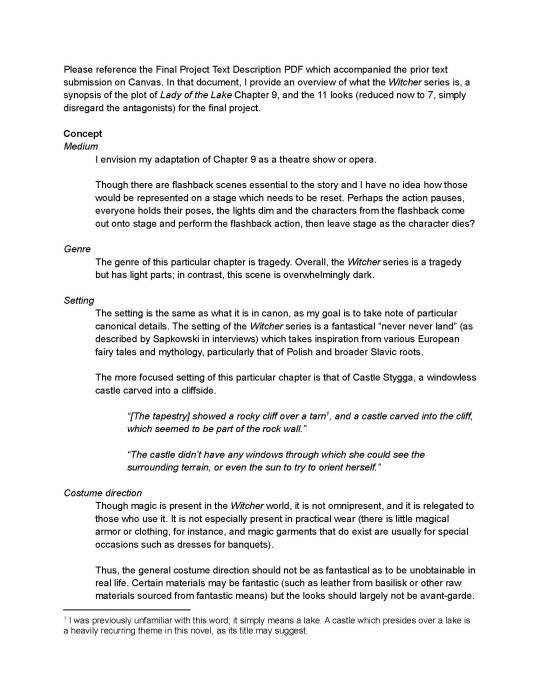
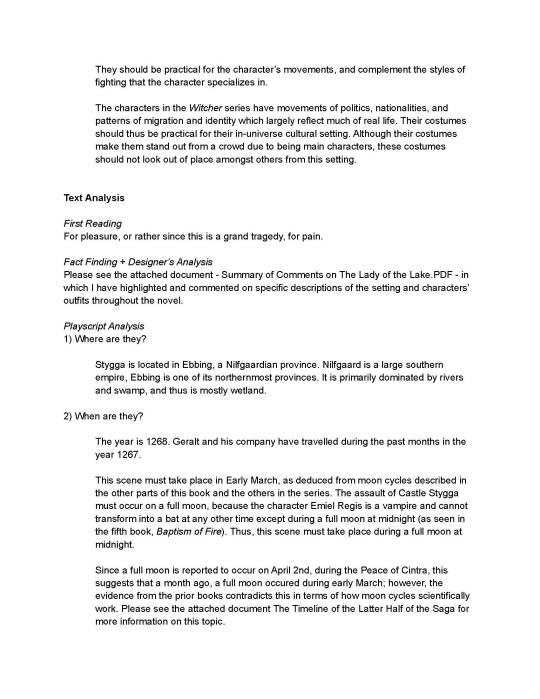



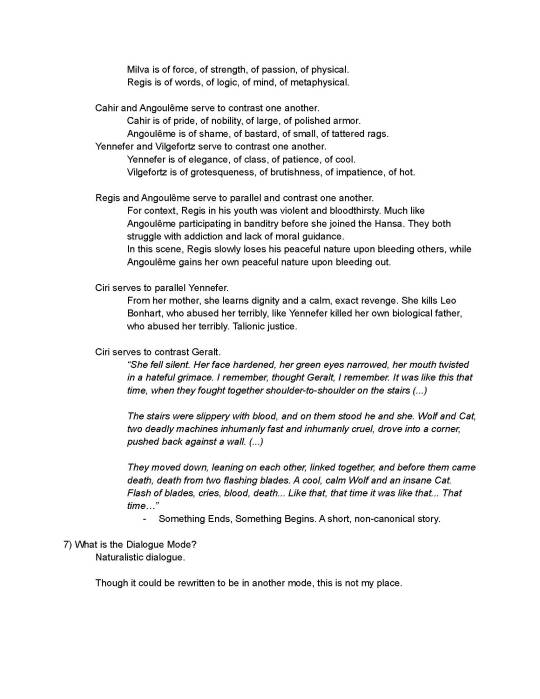

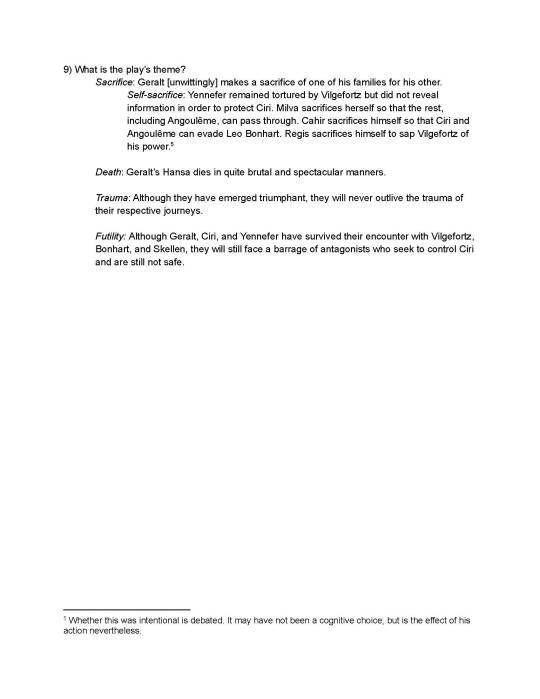
i then combed the chapter and noted how the text is divided into scenes, each separated by a space and asterisk or dot (depending on the language/formatting). there were 35 sections in all, this is a chapter that cuts back and forth between the action a lot, so it was a bit of a challenge to consider the next part: reordering these scenes to be practical in a stage adaptation (where you have certain constraints; you can't cut back and forth between separate situations, because you only have one stage and have to have time to change scenery and stage setup).
however, i was adamant to not cut anything from the adaptation, because all of these scenes were necessary to tell the story.
(i think as it relates to milva and cahir's flashbacks, i would have the action pause, lights dim, and the characters from the flashback walk on stage, appearing as "ghosts" - thus not needing a scene change, just a pause in the action.)

then i did a character breakdown (not included) and a costume plot (below). this is basically planning out which costume each character would be wearing in which scene, and when (if at all) they would need a costume change.


then we did some moodboard work:

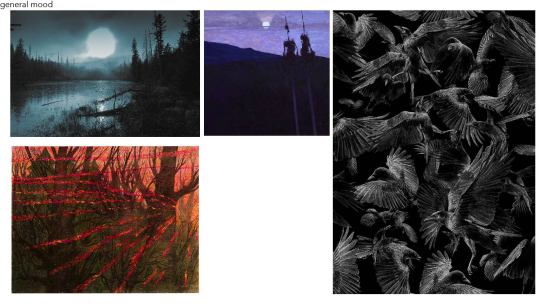
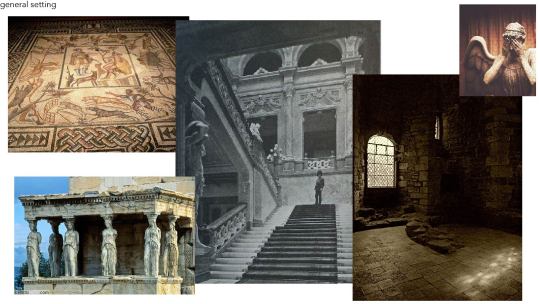
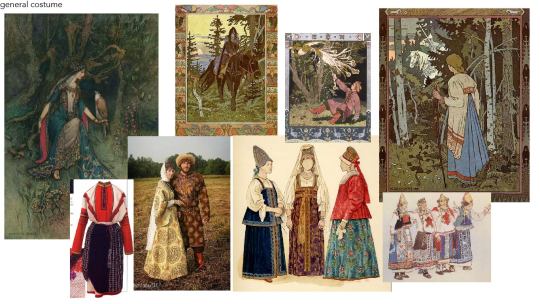

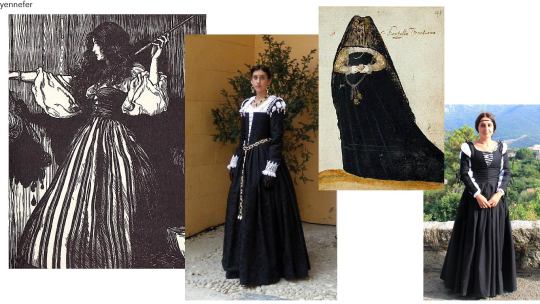
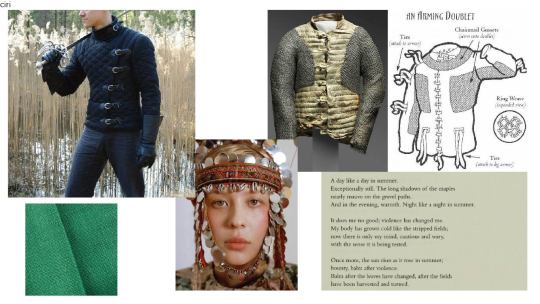
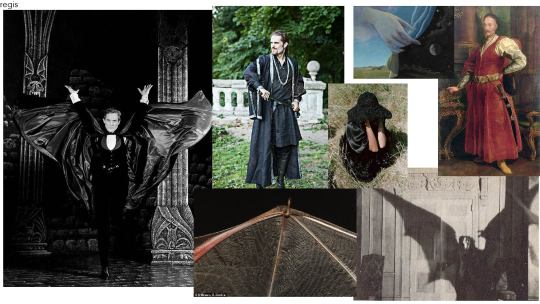



these were my preliminary sketches (NOT FINAL)
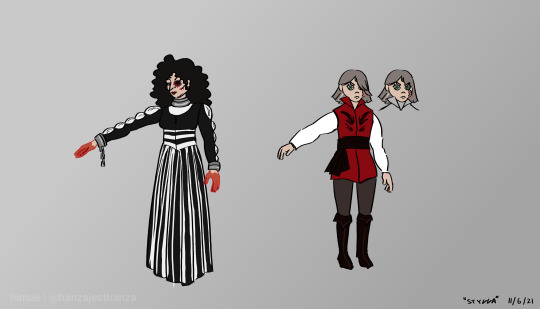
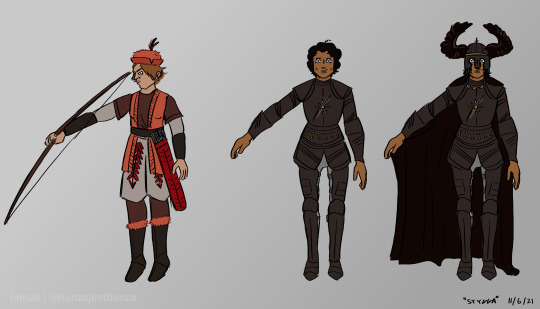
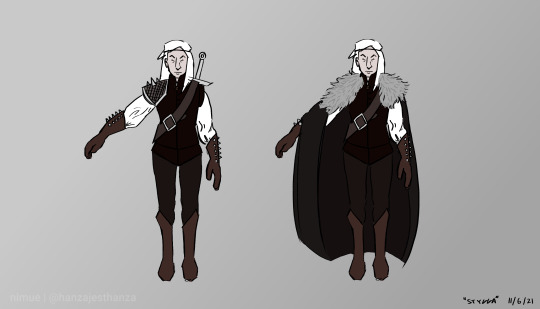
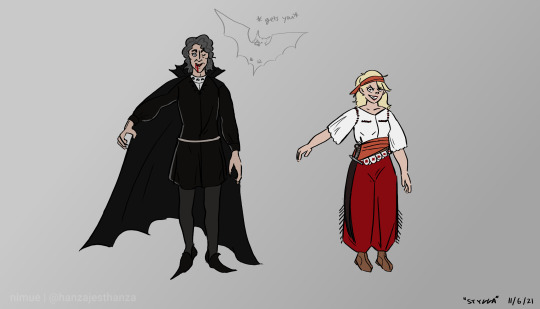
i was happy with how it turned out, but the unfortunate part is that this was a one-credit class and i was absolutely swamped with final projects for my four other four-credit classes at the time, so i didn't get to go "above and beyond" like i usually did with projects, and wasn't able to some of the things i wanted. my next steps would have included:
translate: thoroughly comb the translation for inaccuracies/localizations (i found just a couple things i'd want the casting and makeup to reflect)
adapt: adapt the entire text to a screenplay, note how actors should deliver their lines
stage and lighting design: i did a bit of this, but i had no idea what i was doing, so i just set it aside
choreograph: i said i wanted this to be a ballet, so i would vaguely script out the movements for fight/dance scenes
mechanics: my best idea during this project was to have regis' actor on a mechane. (if you don't know what that is, it's a device used in ancient greek theatre to raise an actor with wires to make them "fly" - medea at the end of euripides' medea, for instance. it's where the term deus ex machina, "god of the machine," comes from). but in order to hypothetically make this happen, i'd need to redesign his costume to allow for special harnesses and safety precautions.
oh, and i also dressed up as dandelion for the final presentation :) he was the one i didn't design, but manifested in real life instead. class was on a friday and the mood was pretty accepting and silly, so i went with it.
19 notes
·
View notes